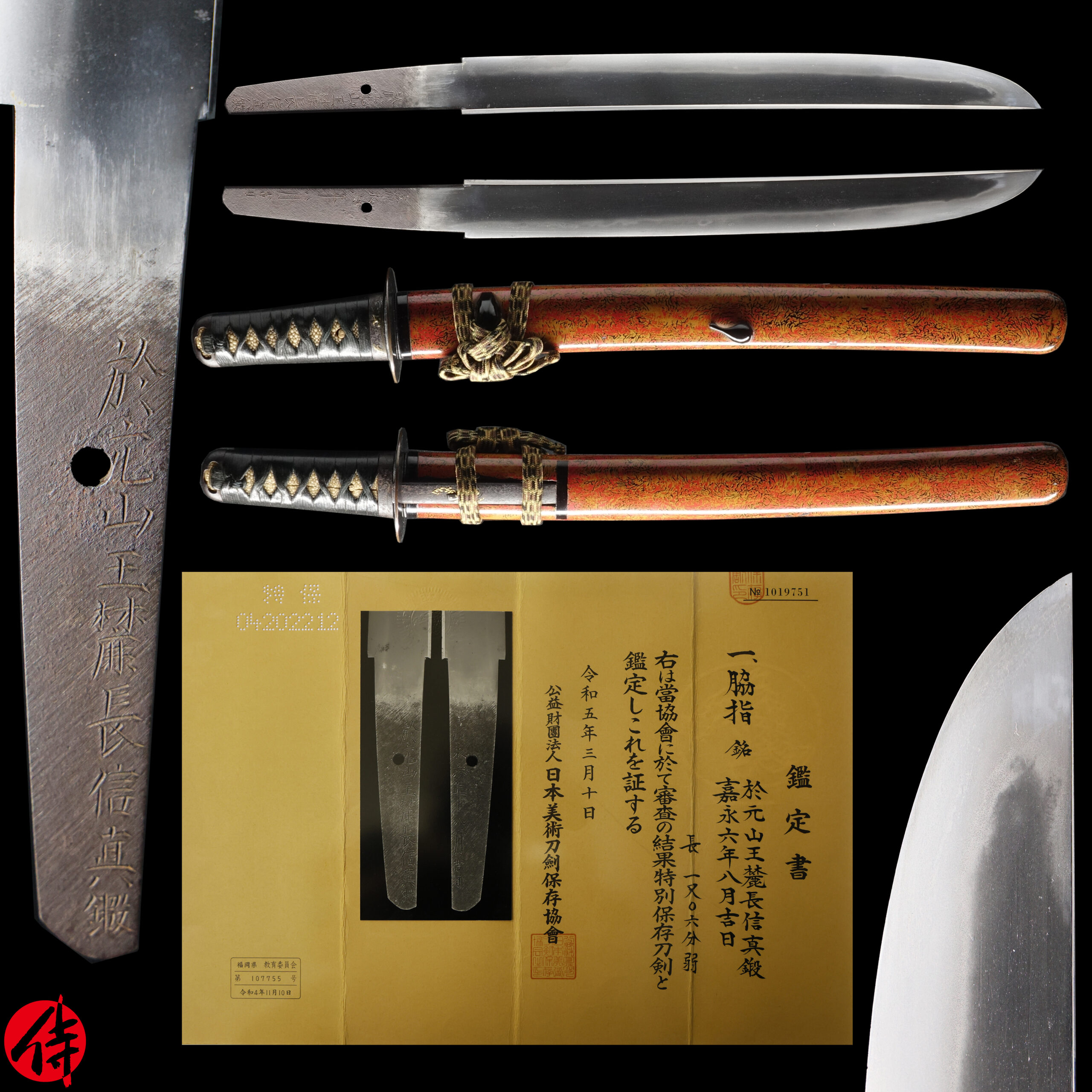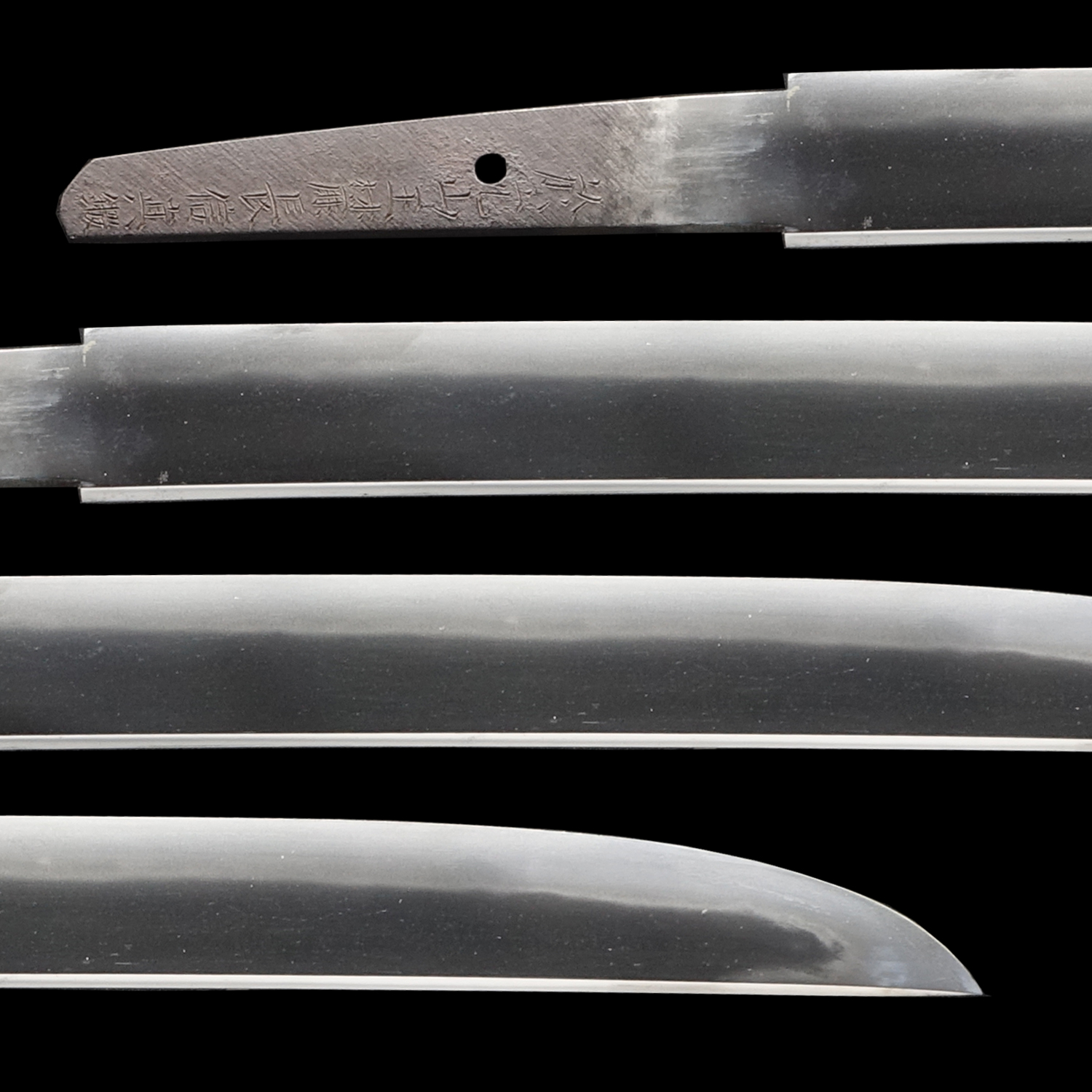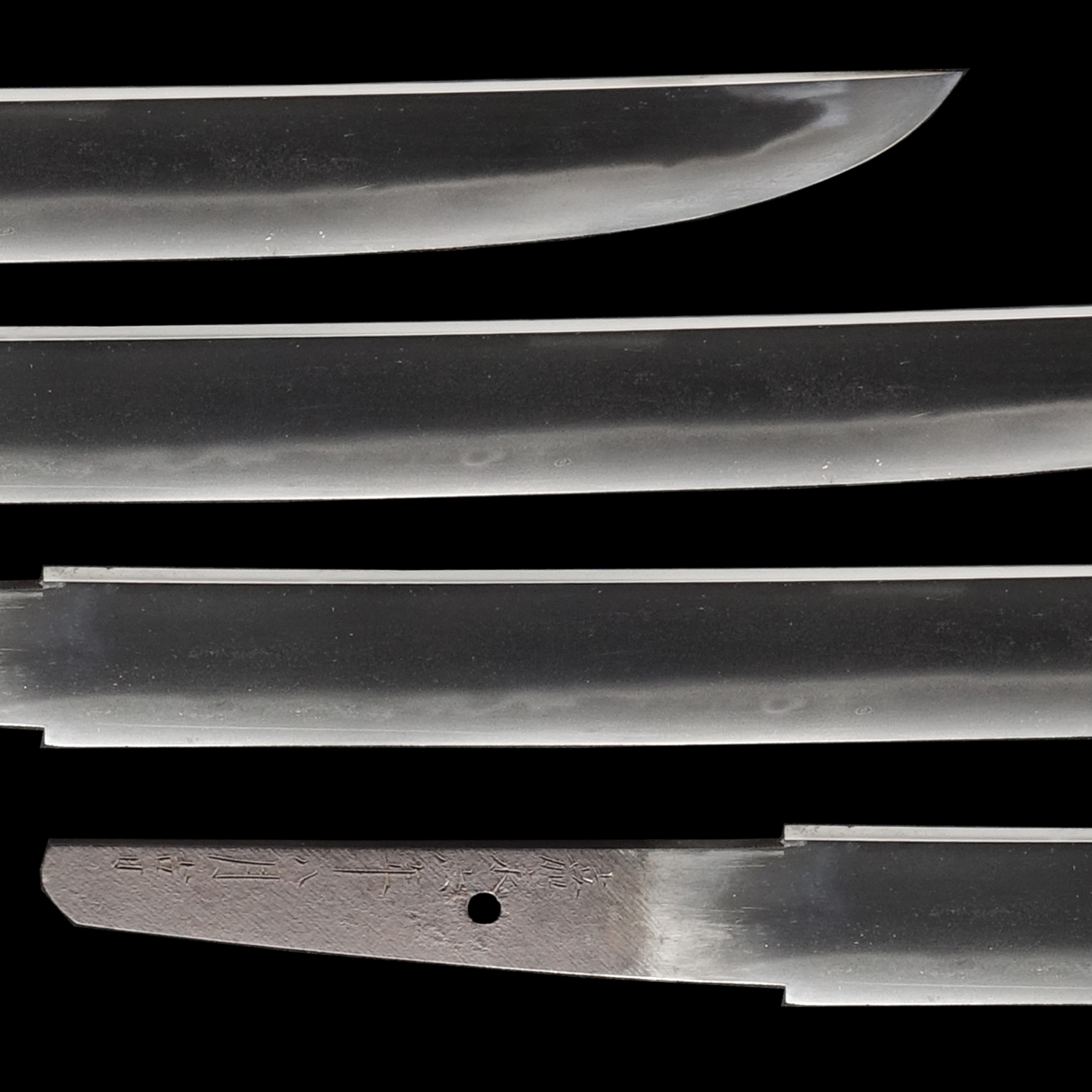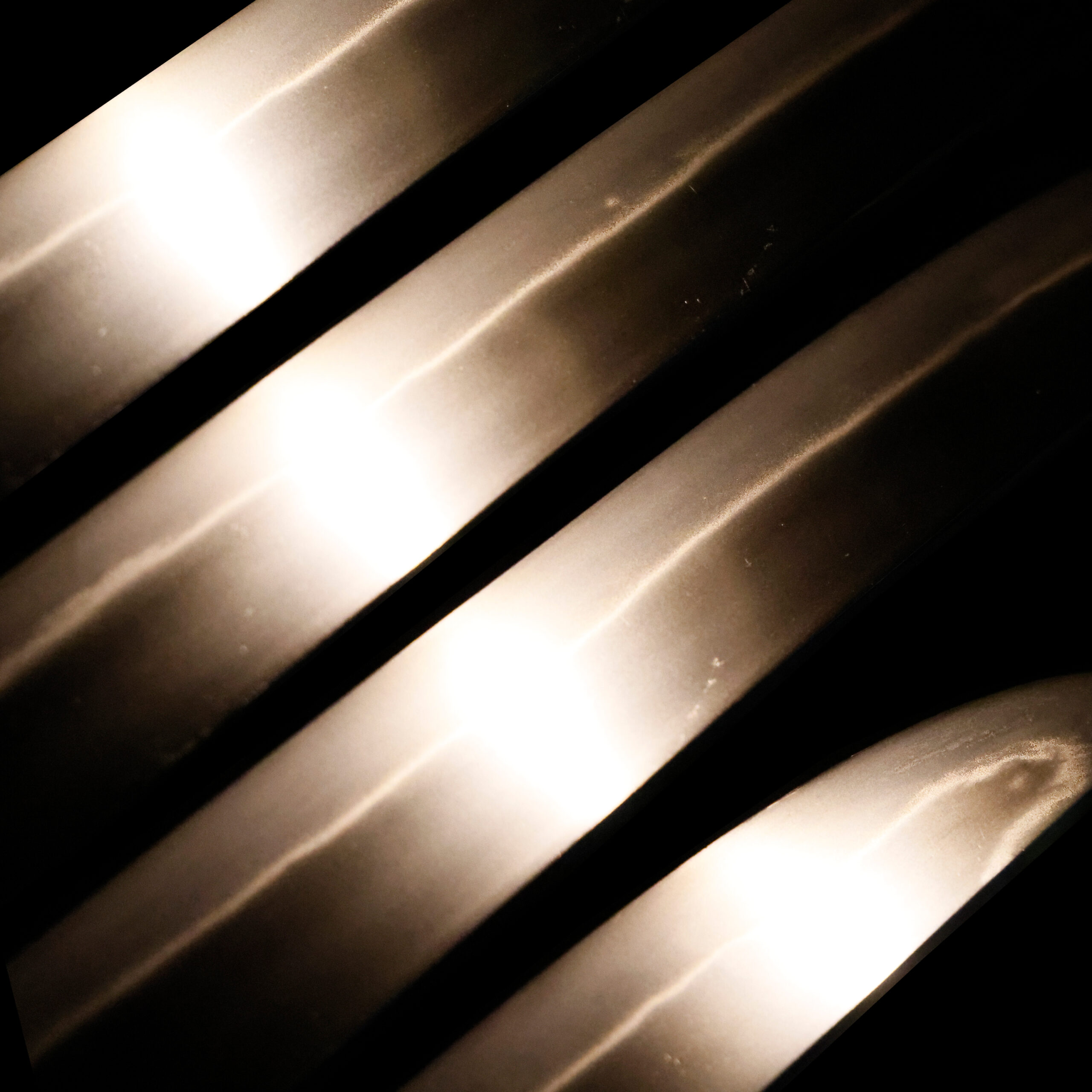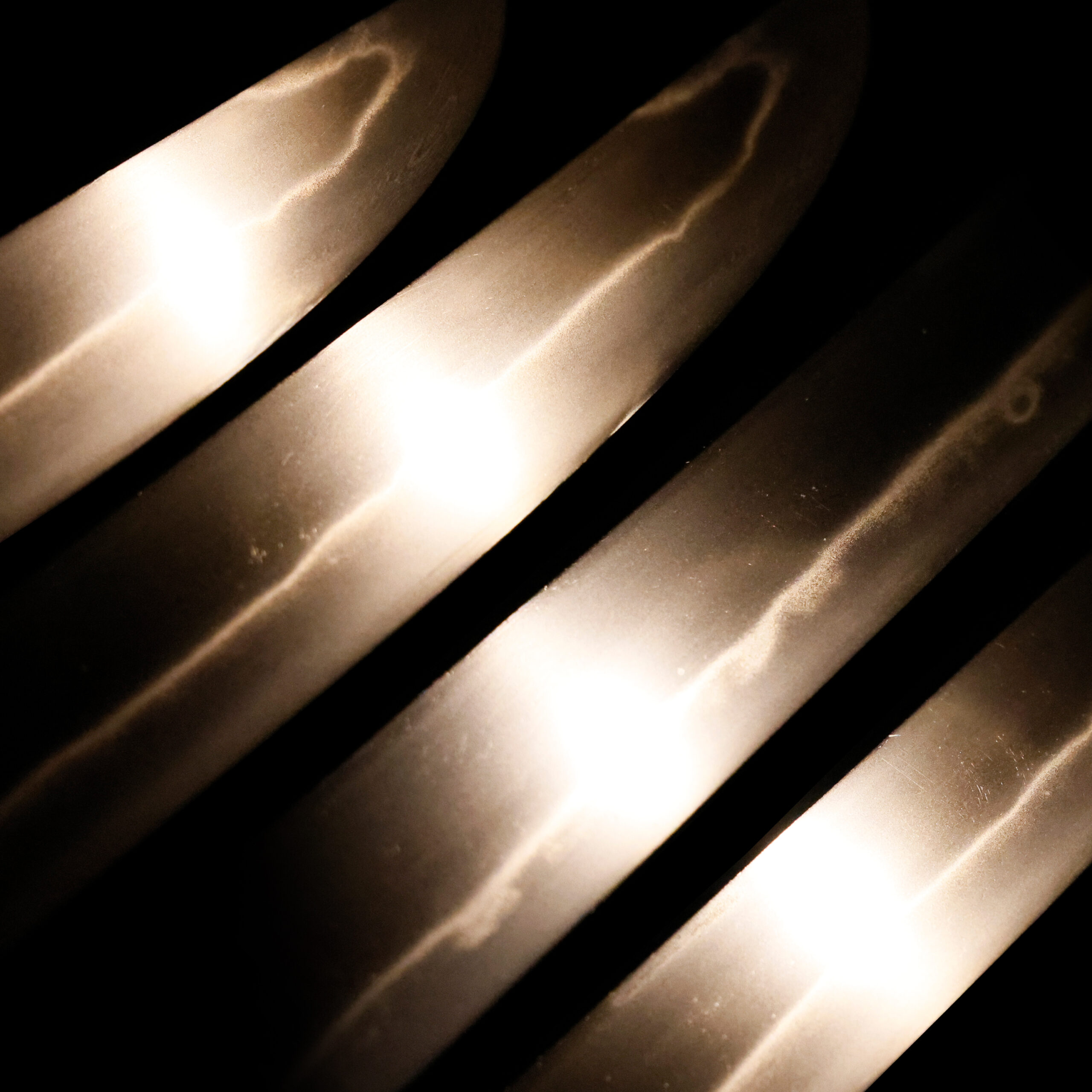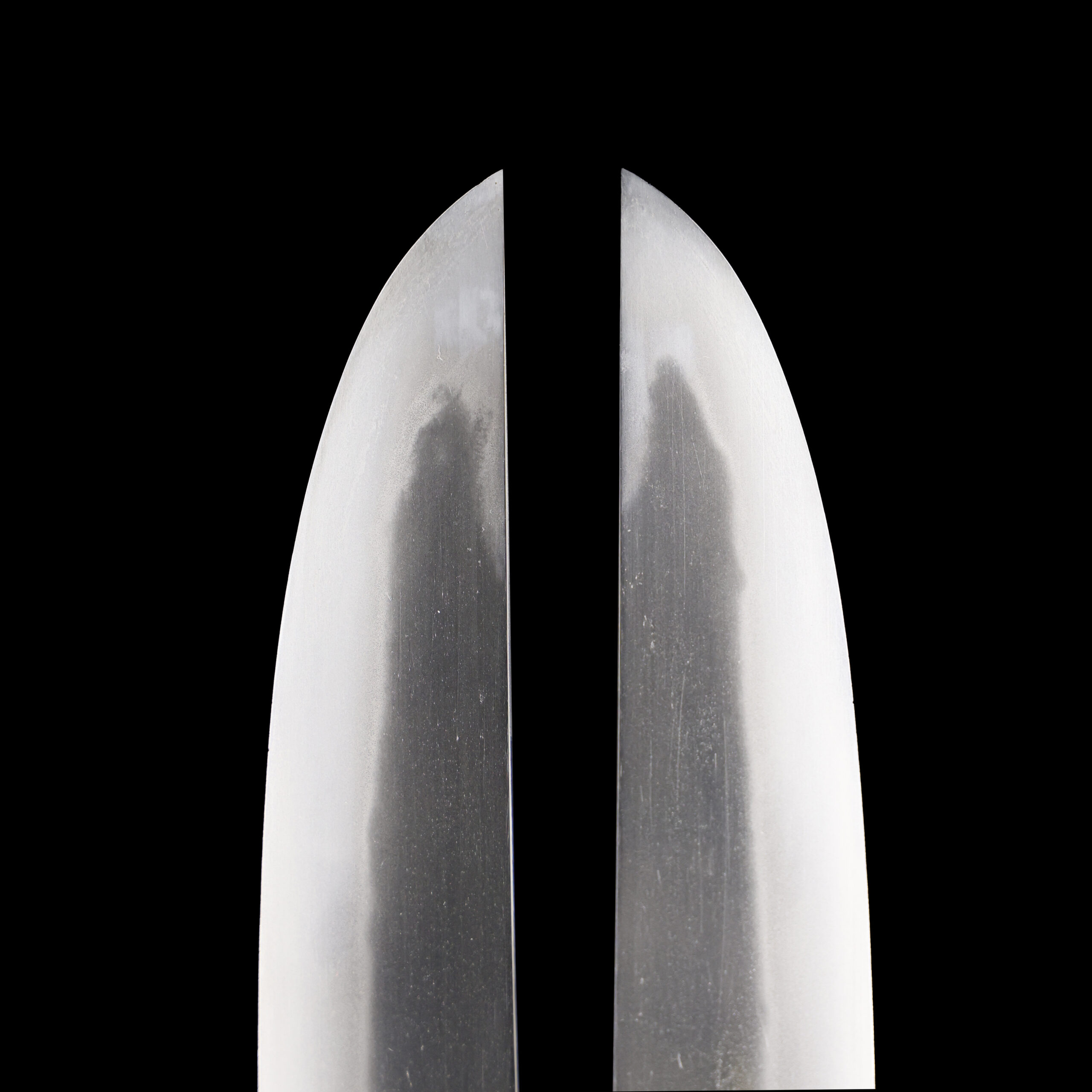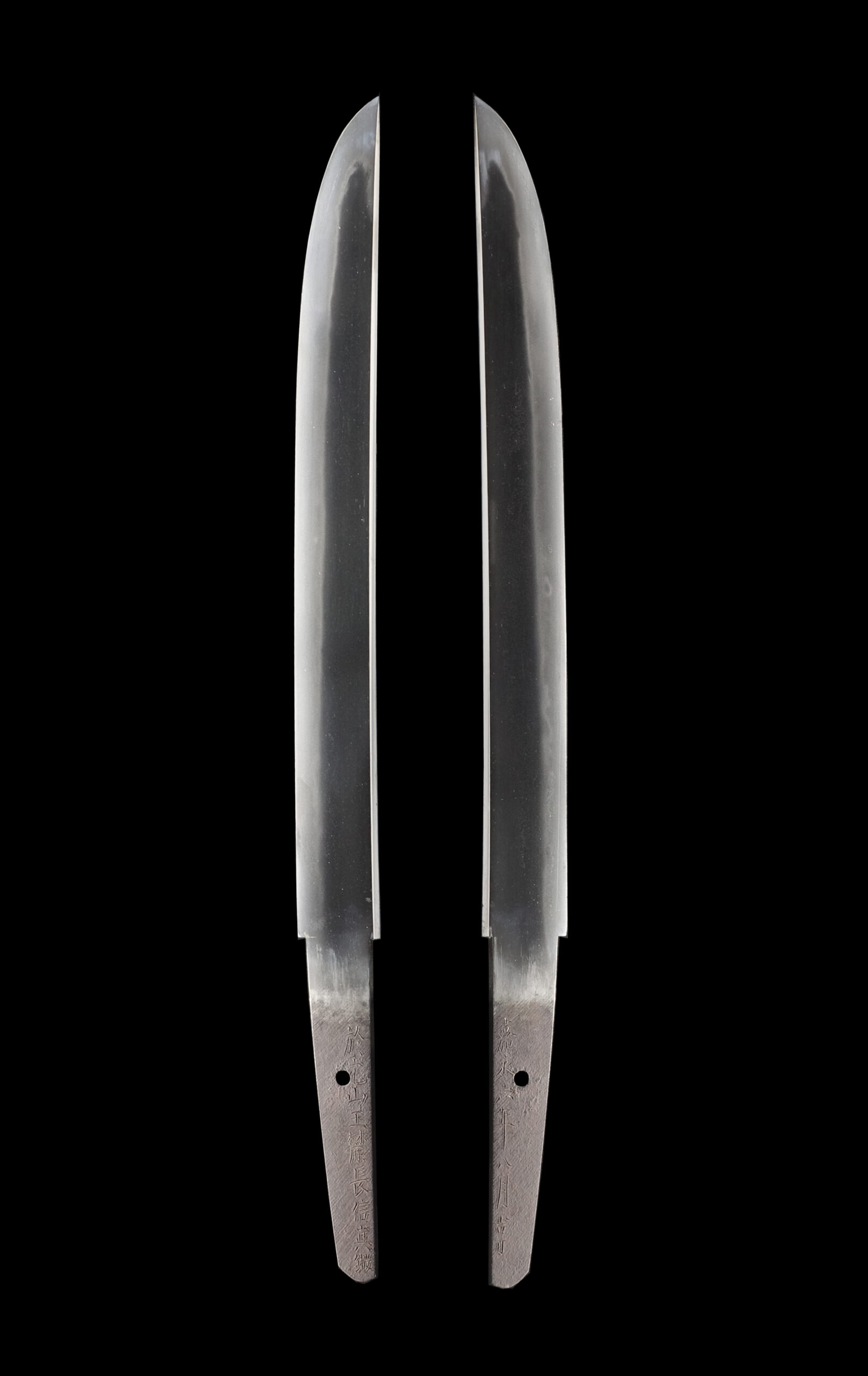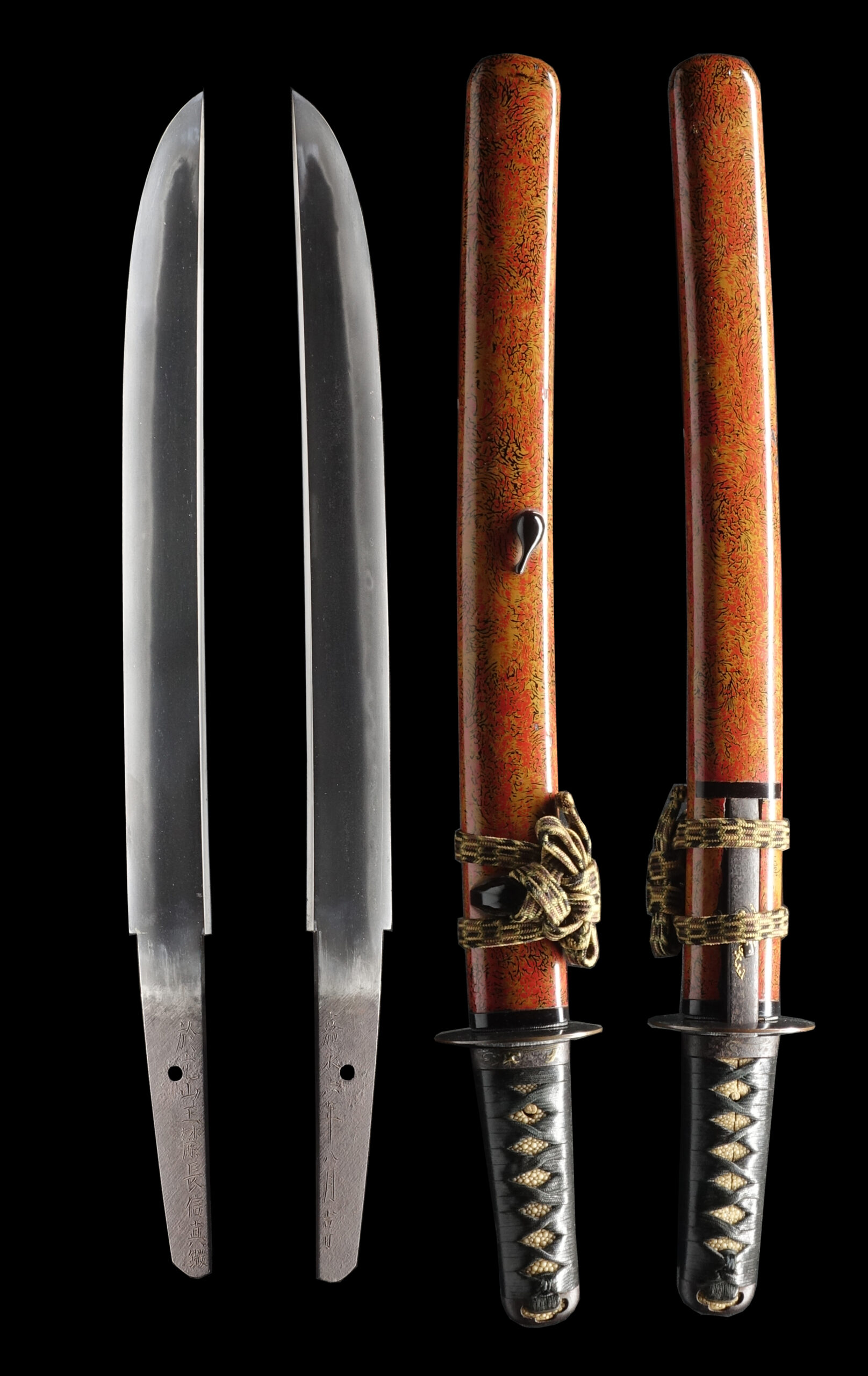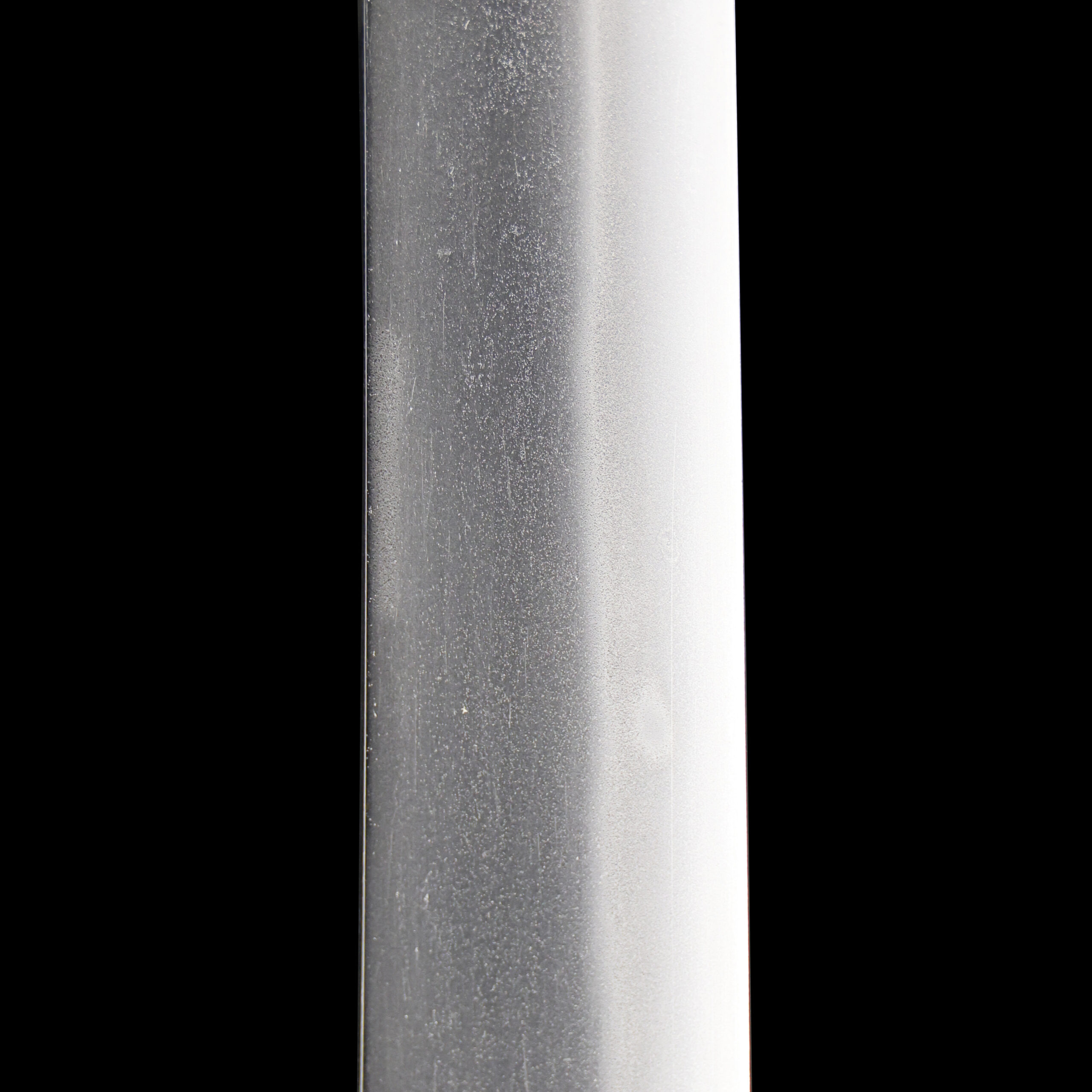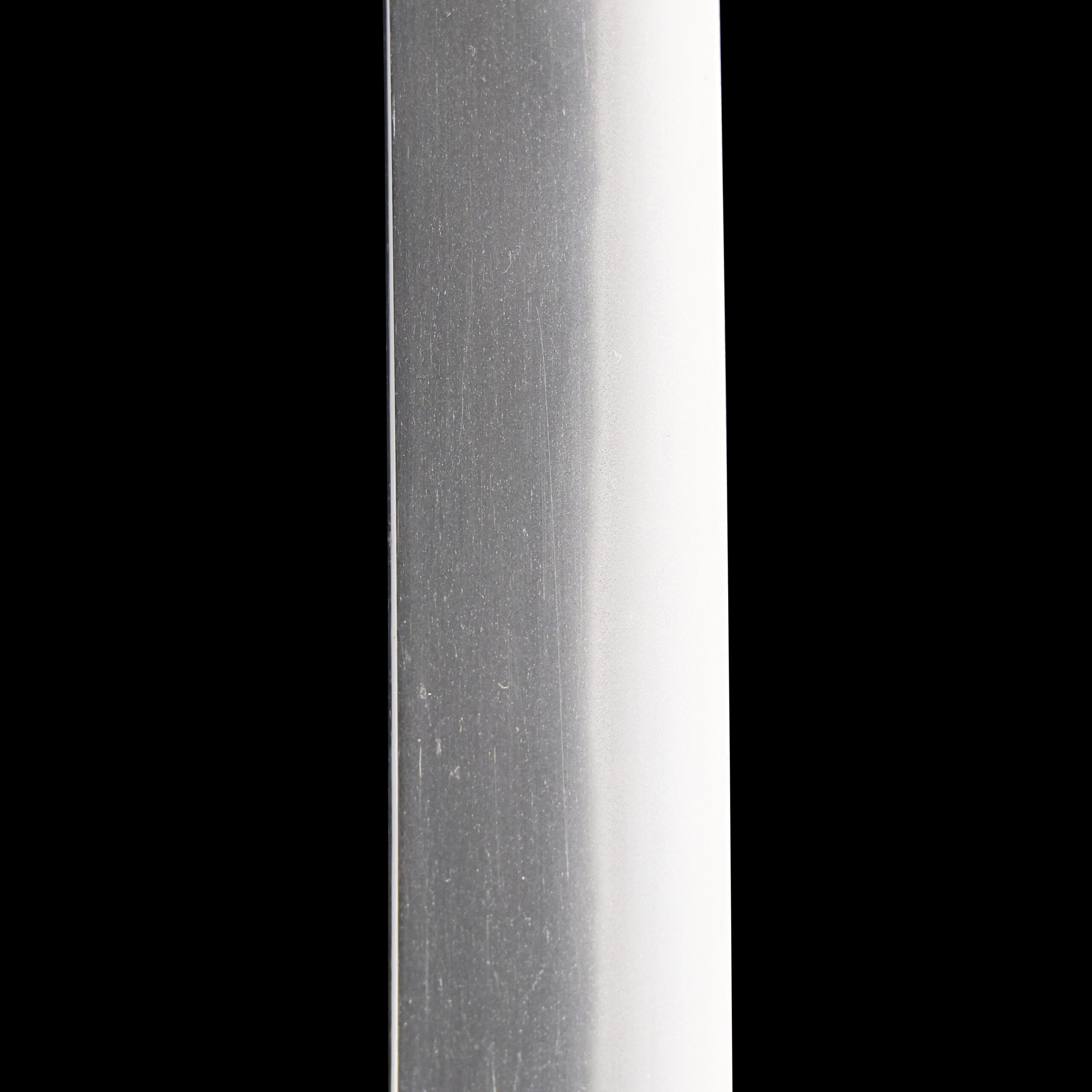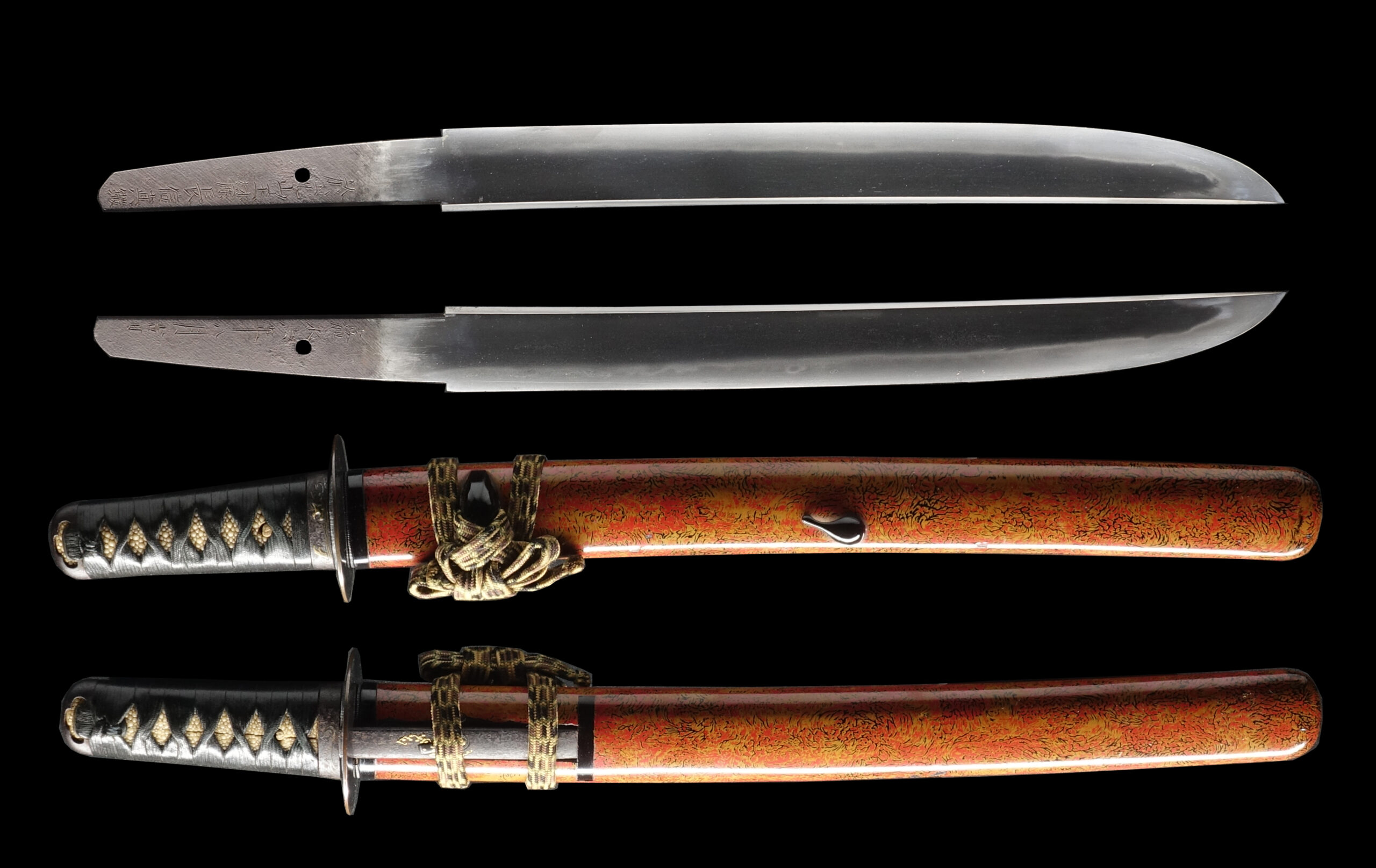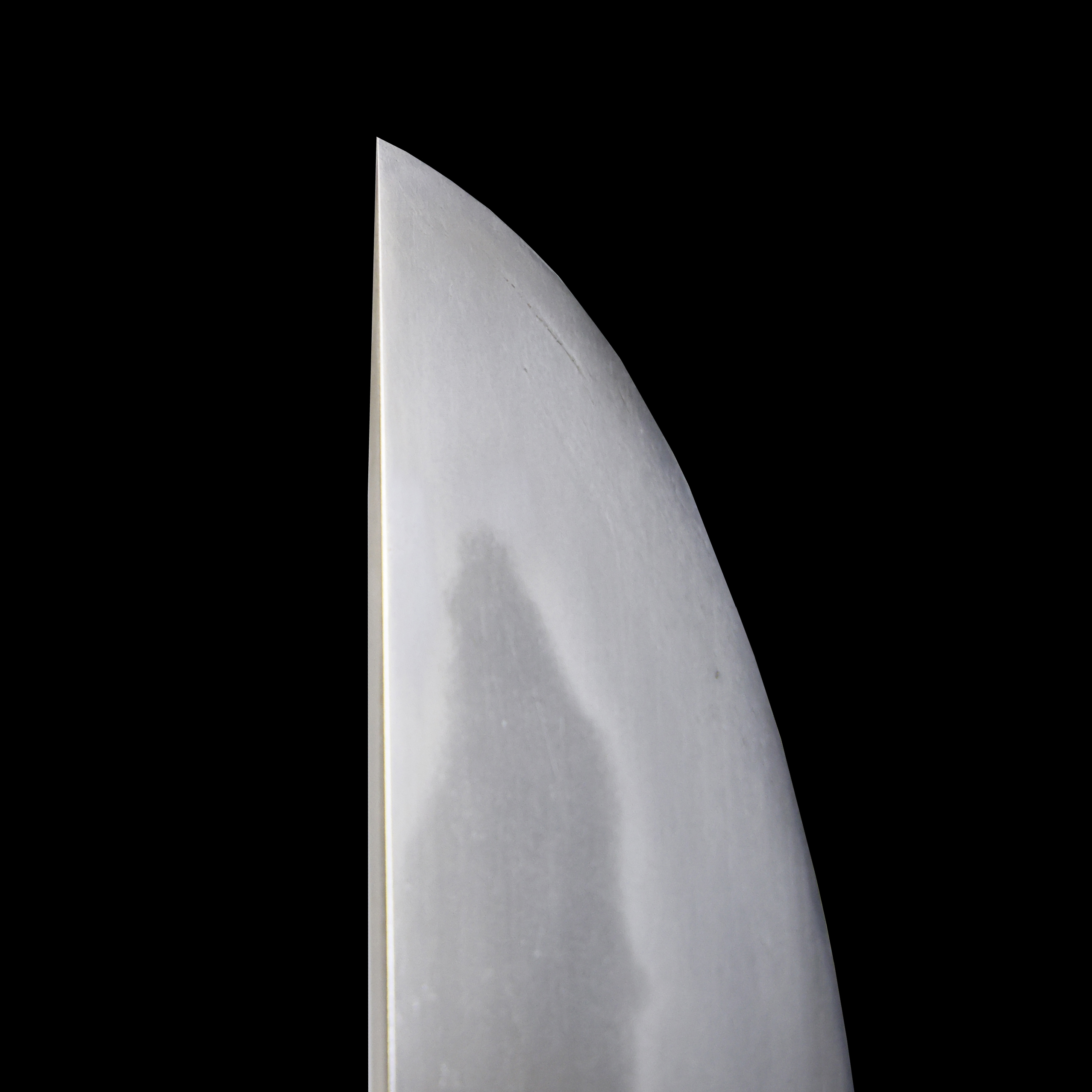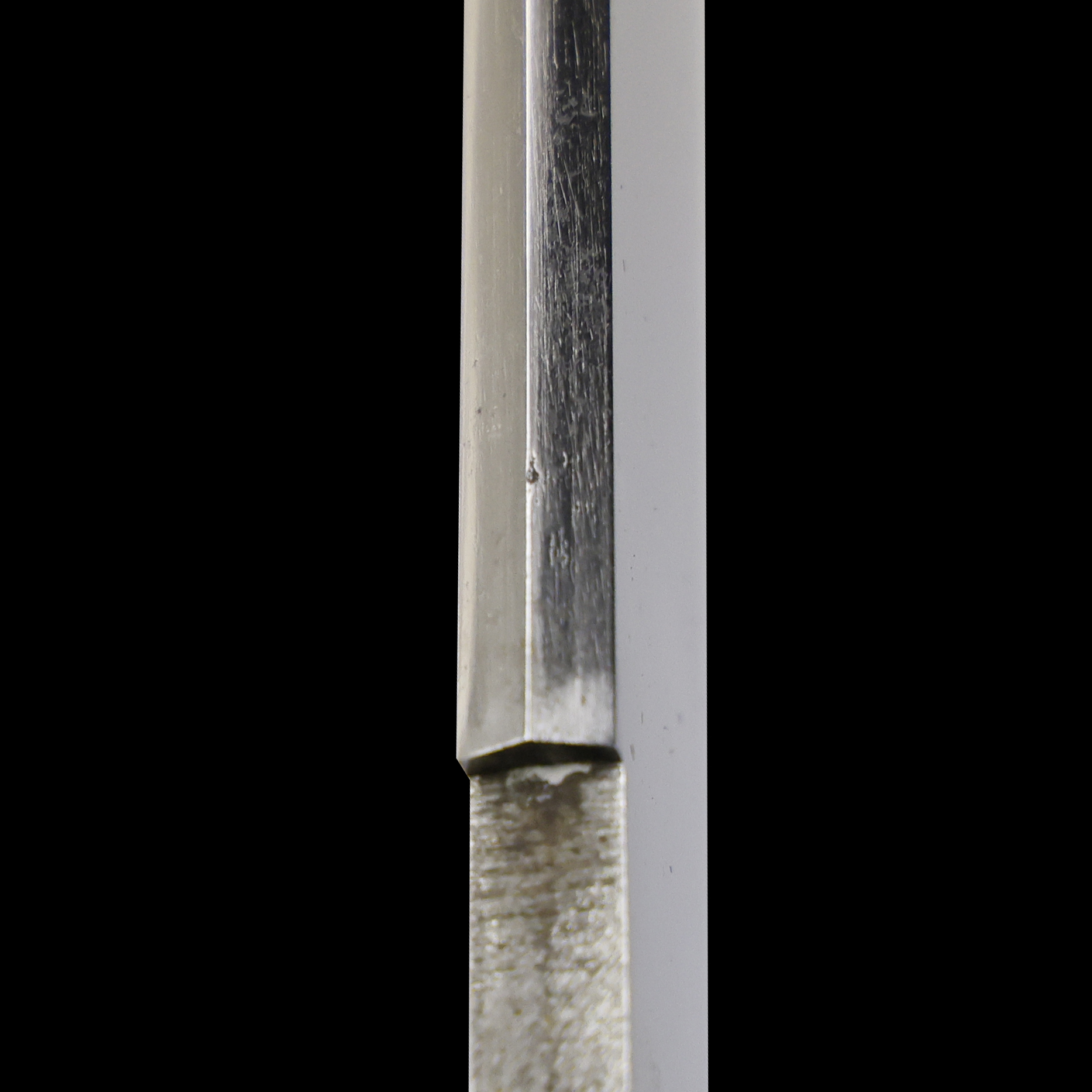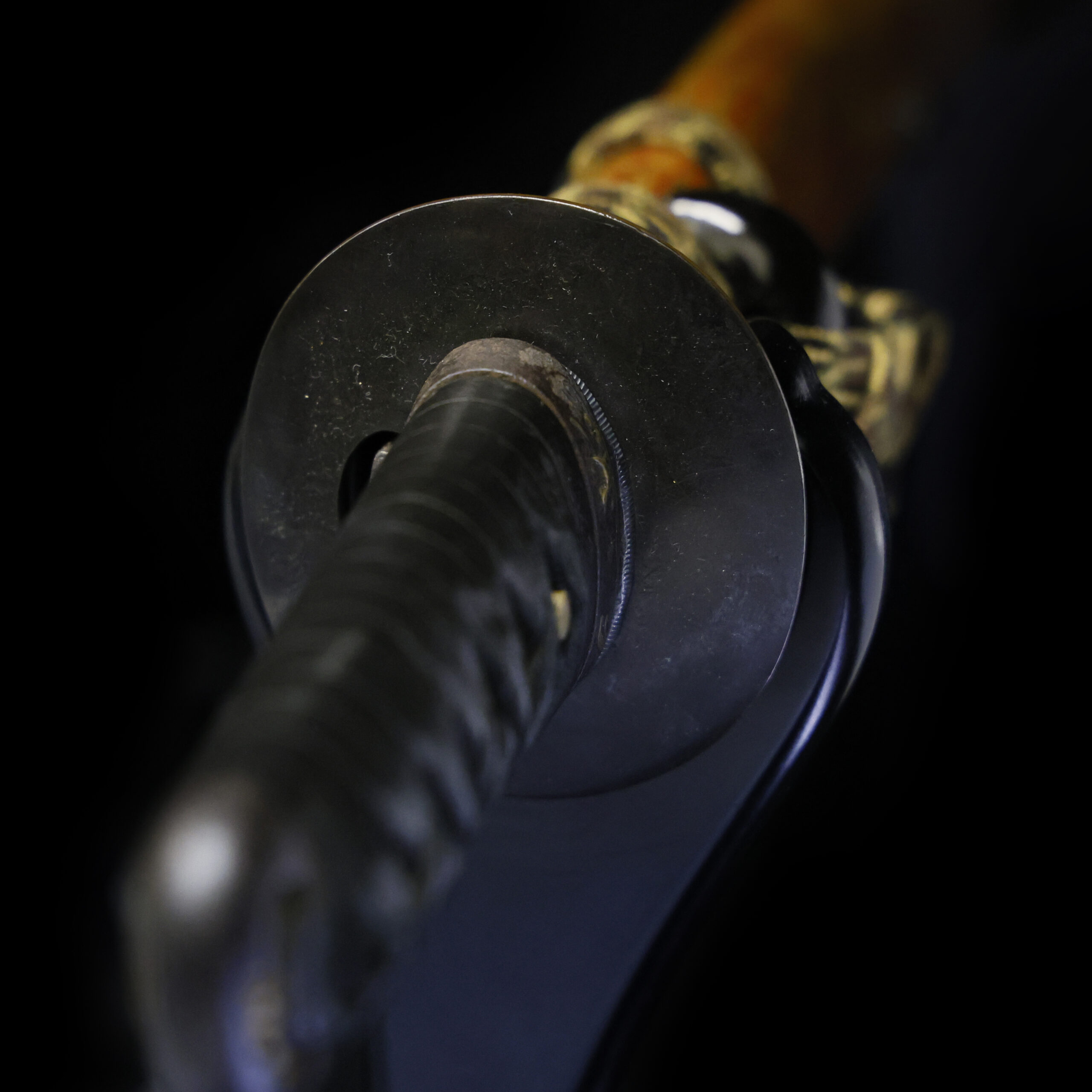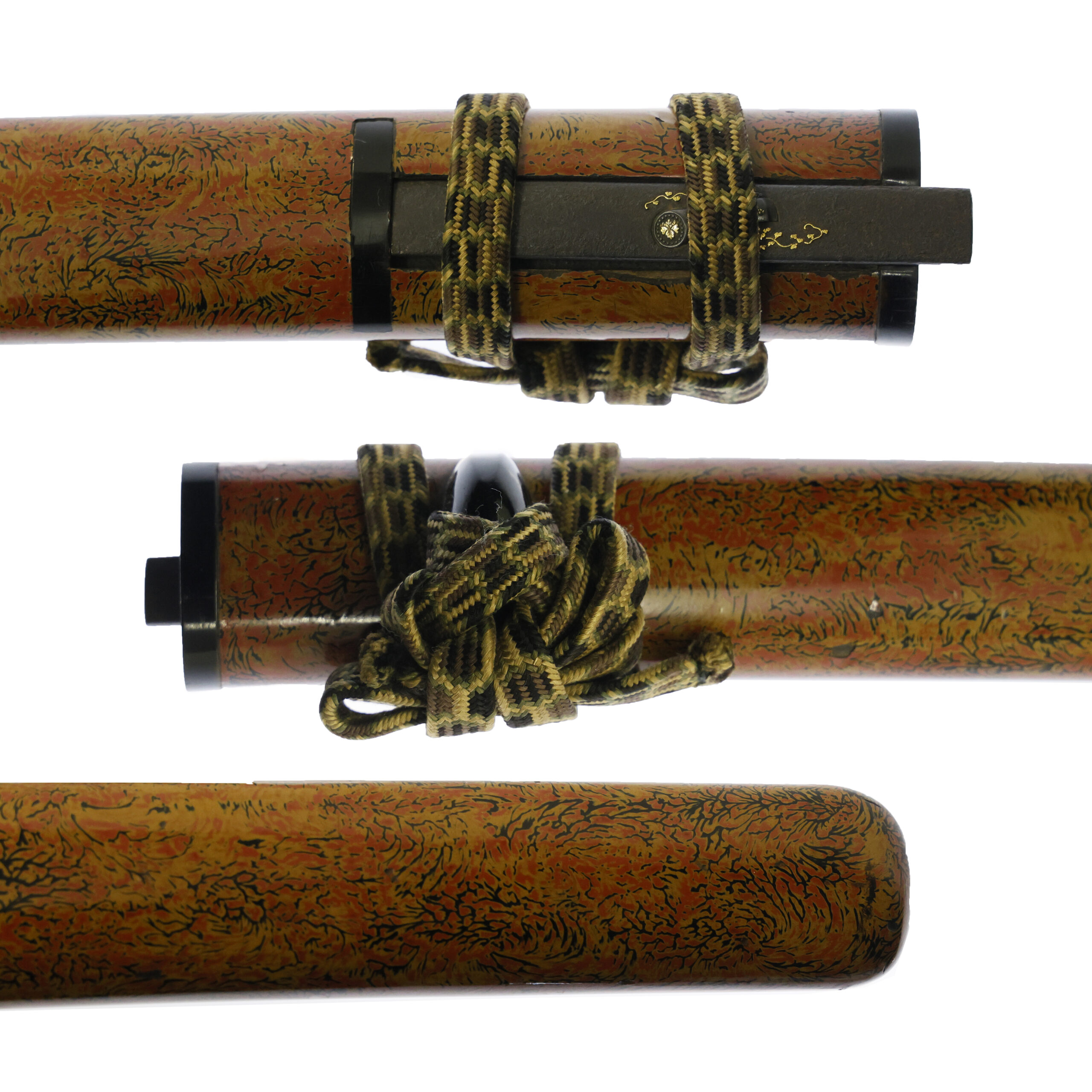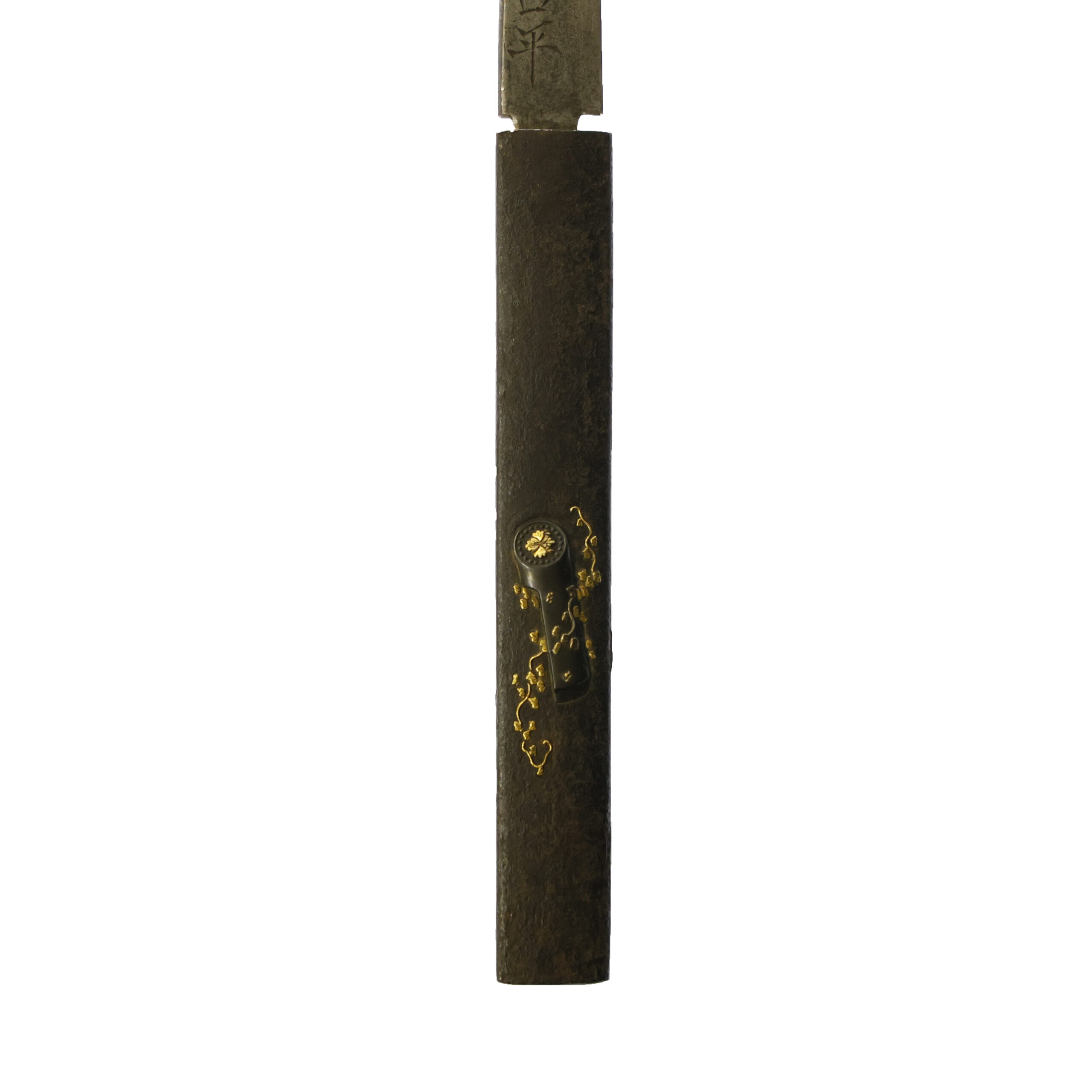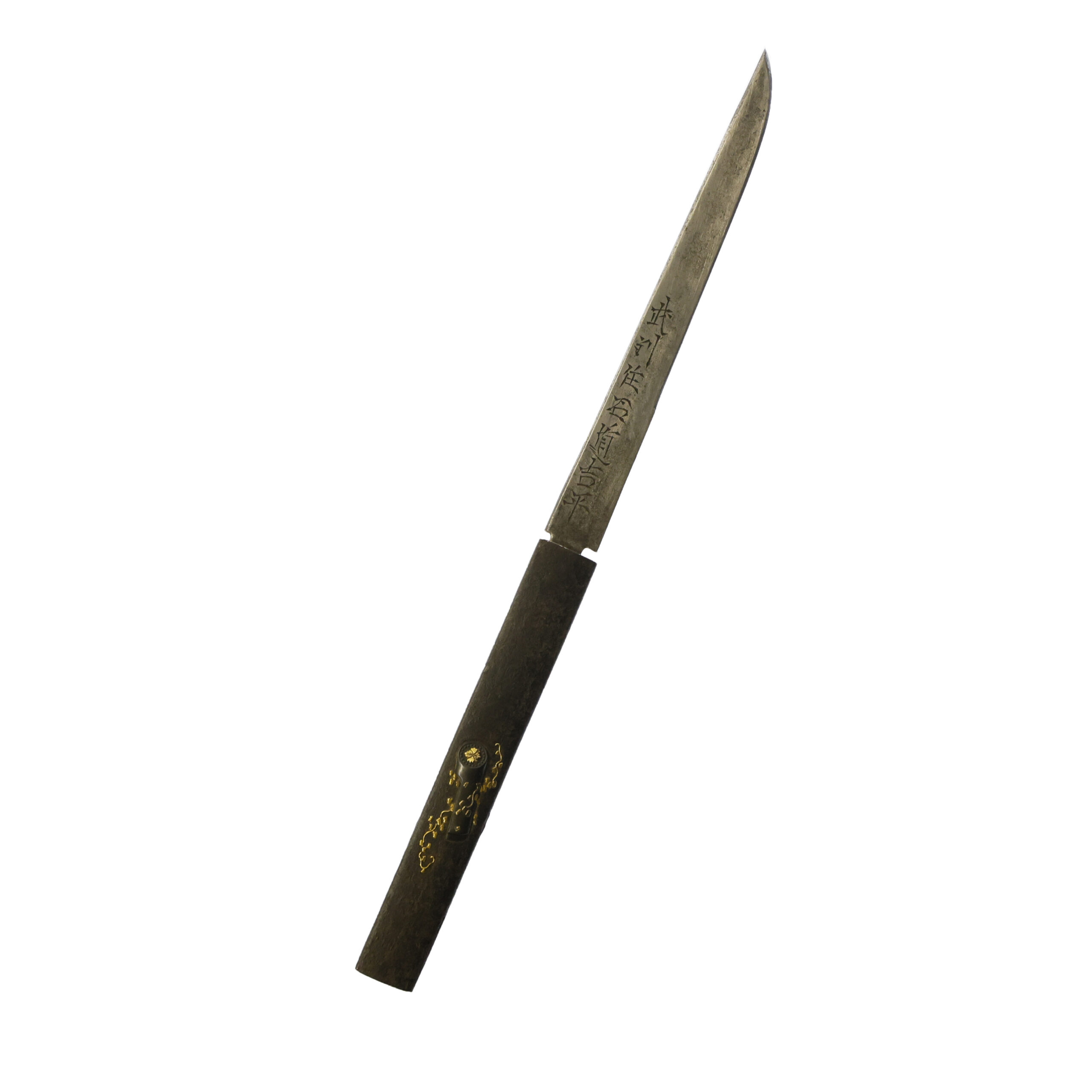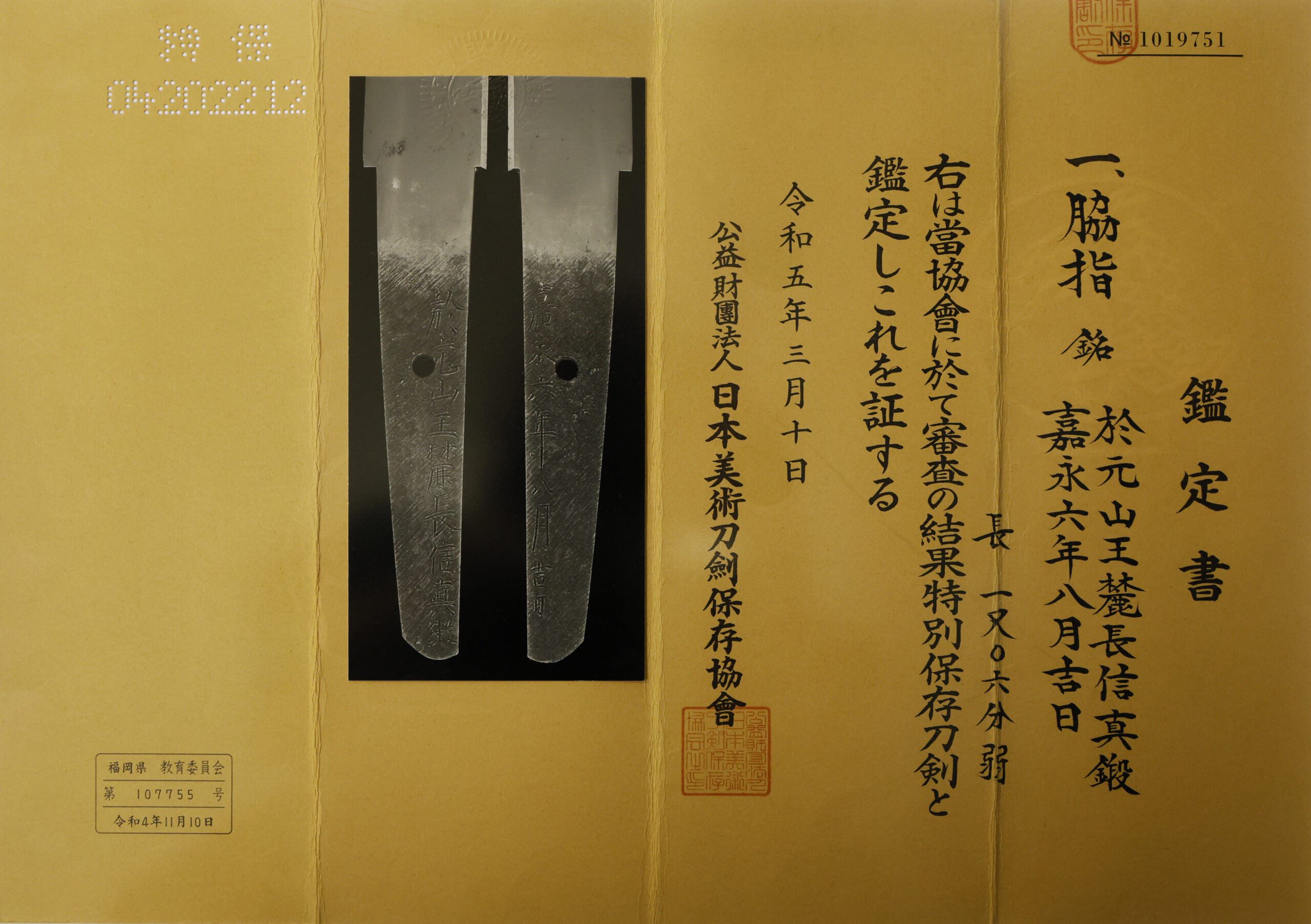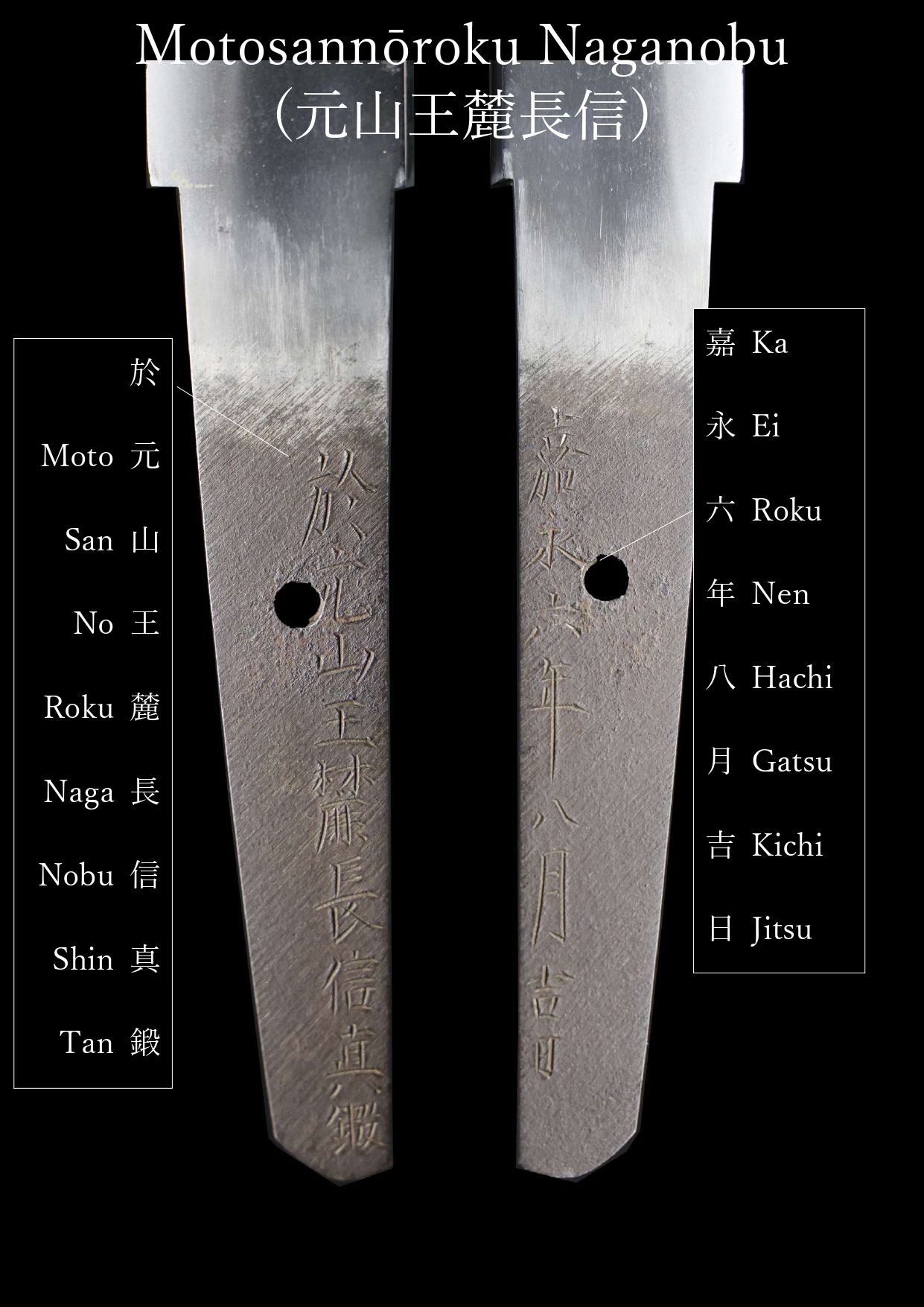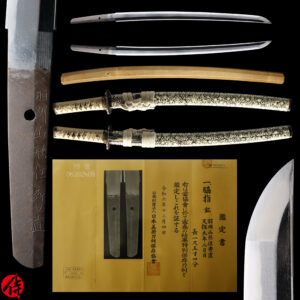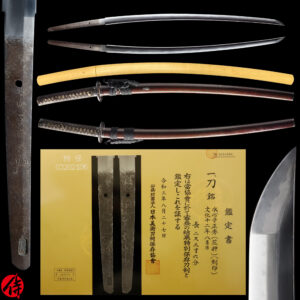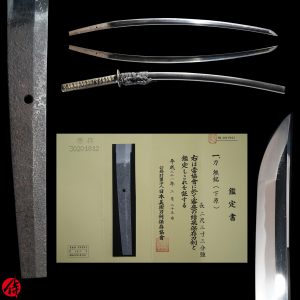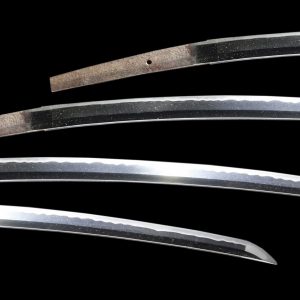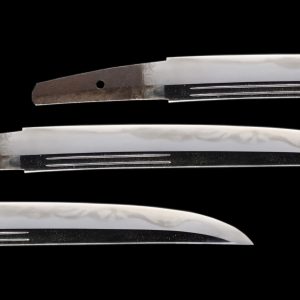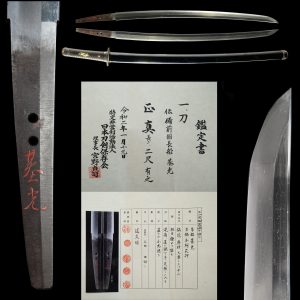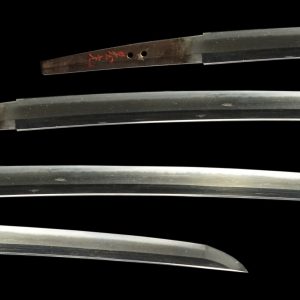Antique Japanese Sword Wakizashi Signed by Naganobu with NBTHK Tokubetsu Hozon Certificate
【Description】
This sword bears the inscription “Motosannōroku Naganobu” (元山王麓長信). According to the appraisal by the NBTHK (Society for the Preservation of Japanese Art Swords), it was forged in 1853 (Kaei 6)—the very year that Commodore Perry arrived in Japan, a historic event that marked the beginning of the country’s opening to the outside world.
At that time, the swordsmith Naganobu (高橋長信, Takahashi Naganobu) was 37 years old. He had recently returned to Edo (Today’s Tokyo) after a temporary stay in Matsue, and evidence from inscriptions and historical maps indicates that he was working in the Motoyama area, near present-day Akasaka, which was the former site of the Hie Shrine before the Great Fire of Meireki.
Naganobu was the seventh-generation successor of the Takahashi family of swordsmiths, who served the Matsue domain (Izumo Province). Originally born the second son of a farming family, he was adopted into the Takahashi household and showed exceptional promise from an early age. He later trained in Edo under the renowned swordsmith Kato Chōunsai Tsunatoshi, a prominent figure of the time. His extraordinary skill earned him the rare privilege of studying in Edo at the domain’s expense, a testament to his talent.
Over the course of his career, Naganobu used various signatures, including “Naganobu,” “Fuyuhiro Naganobu,” and “Chōunsai Fuyuhiro,” reflecting his lineage and respect for his teacher. Around 1853, he often incorporated references to his mentor or family line into his inscriptions.
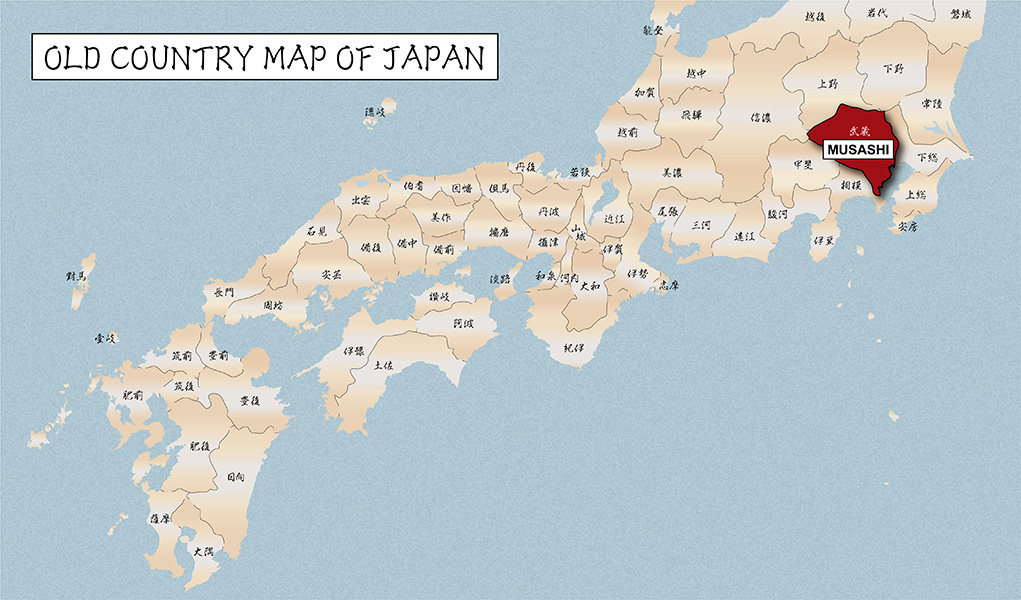
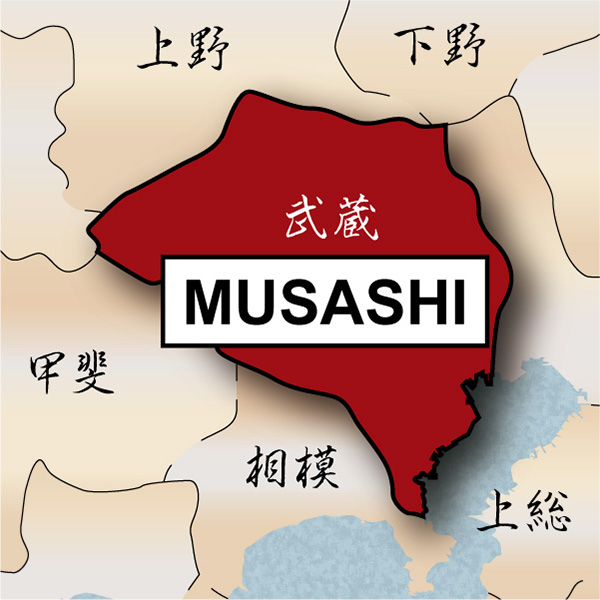
About late Edo period
The Bakumatsu period (幕末) was the final part of Japan’s Edo period, lasting from around 1853 to 1868. It began when American ships led by Commodore Perry arrived in Japan and encouraged the country to open its ports to international trade. This moment was a turning point in Japanese history. Many people in Japan were surprised by Western technology and started thinking about how the country should respond to the changing world.
At the time, there were strong debates between those who supported the traditional Tokugawa shogunate and others who believed Japan needed to modernize and return political power to the Emperor. These disagreements eventually led to conflict and the end of samurai-led government.
Samurai were important figures during the Bakumatsu period. Their swords, known as Katana, were not just weapons but also powerful symbols of their values and way of life. However, as Japan began to build a modern army and adopt new weapons, swords became less common in battle.
It is appraised as a Tokubetsu Hozon Token (特別保存刀剣) issued by NBTHK (Nihon Bijutsu Touken Hozon Kyokai: 日本美術刀剣保存協会). This authentication paper was only given to authentic Japanese swords, especially well preserved and high quality with artistic value.
*Please keep in mind that there is a tinny chip on the tip of this blade. If you don’t mind waiting, we will have this part polished without additional cost so that the chip will be barely noticeable. If you like to know the detailed condition, please feel free to contact us.
【Blade】
Cutting Edge Length (Nagasa):32.0 cm (12.5inches)
Curvature (Sori): 0.2 cm (0.07 inches)

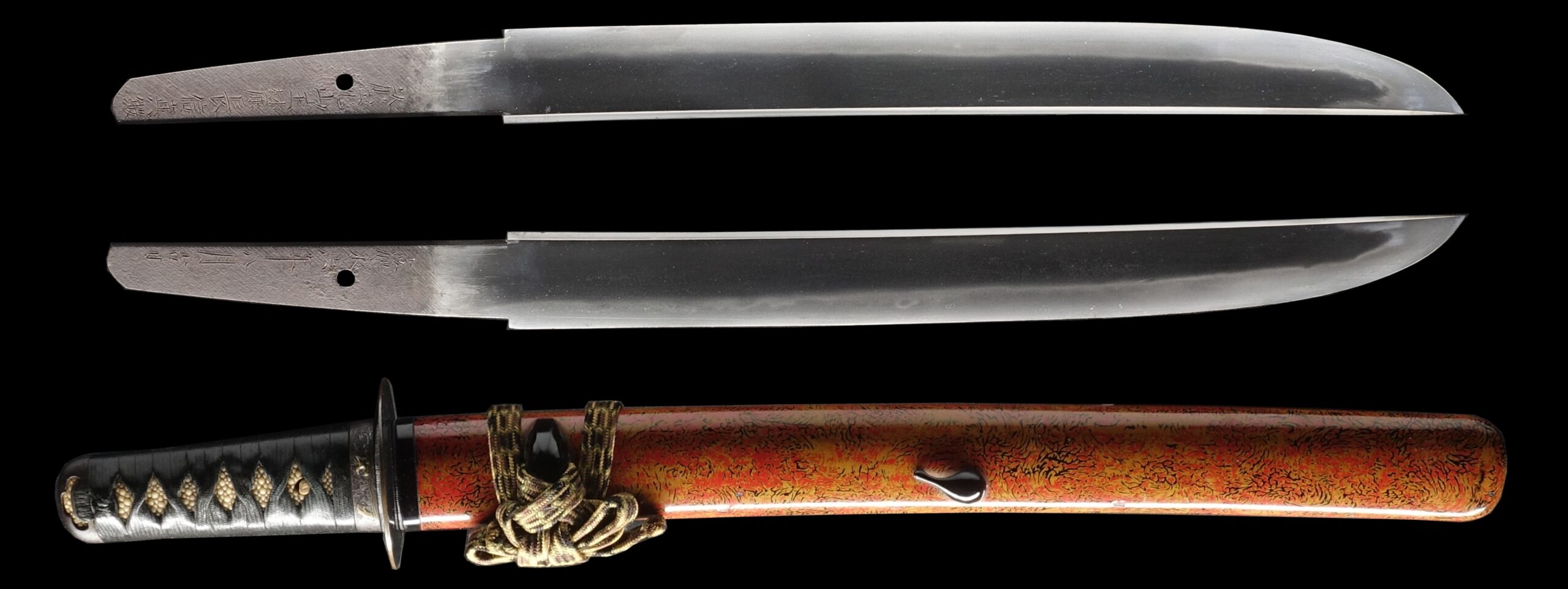
Hamon:
The crystalline structure which forms along the cutting edge of a blade as a result of the hardening process.
Jimon(Jihada):
visible steel surface pattern created by folding and hammering during forging process
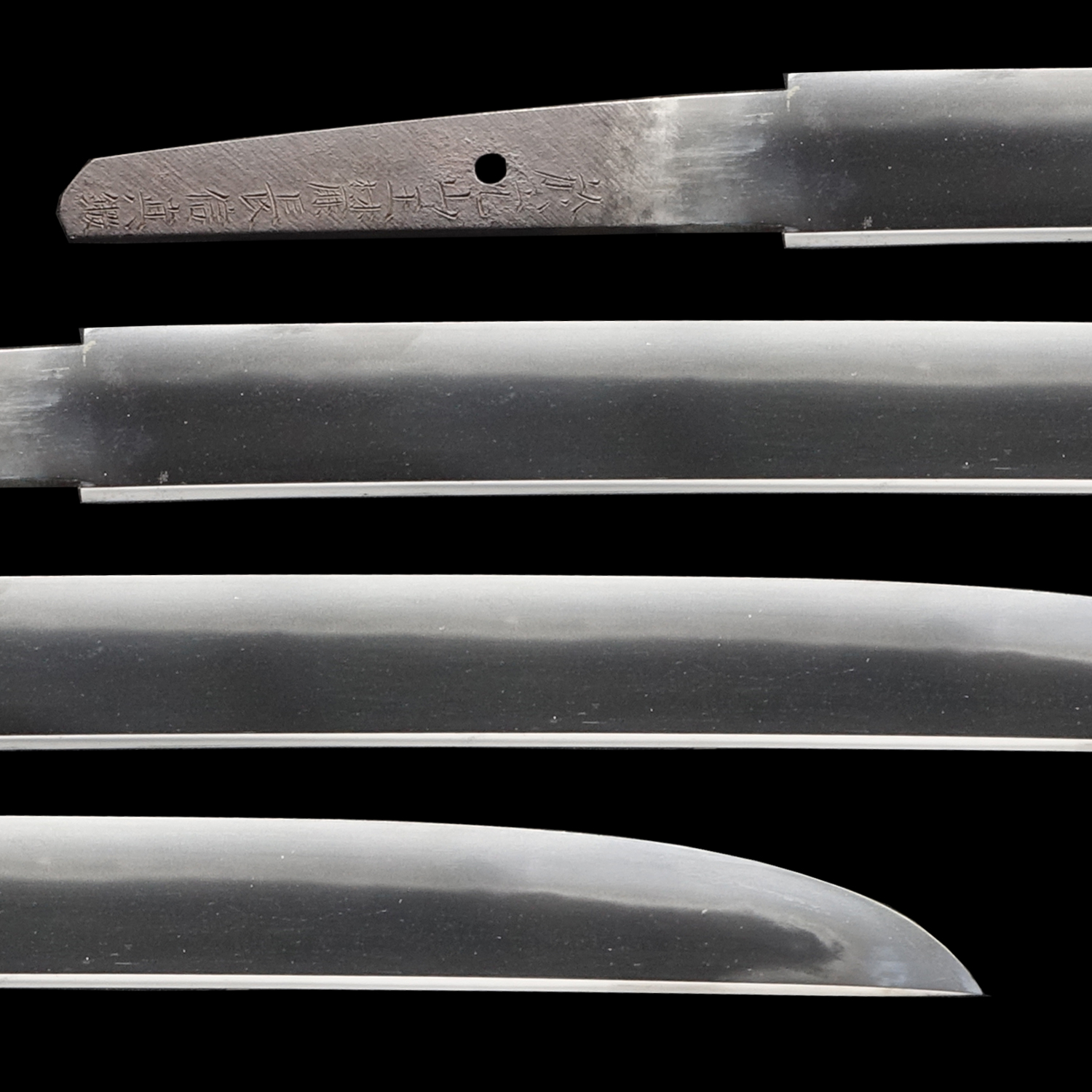
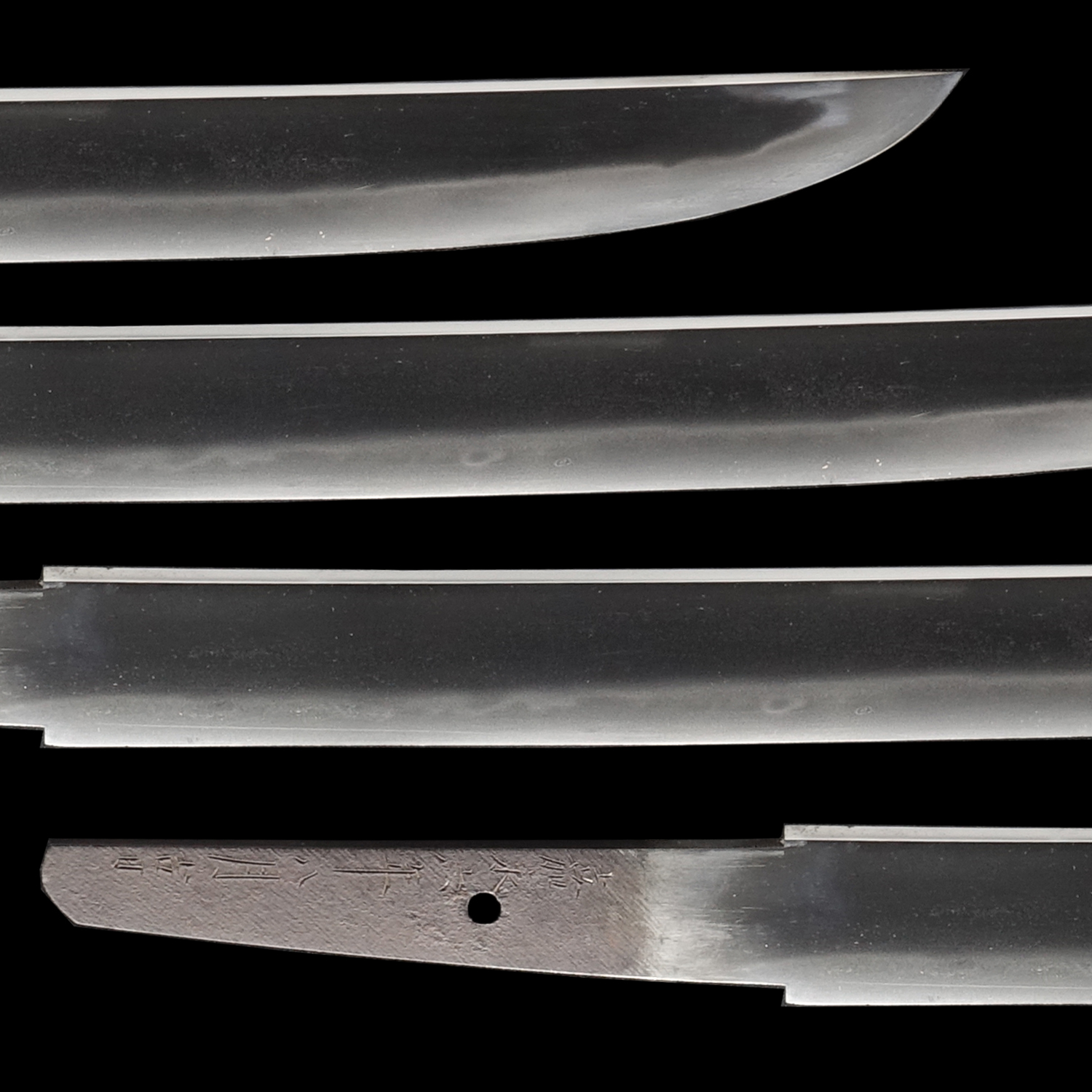
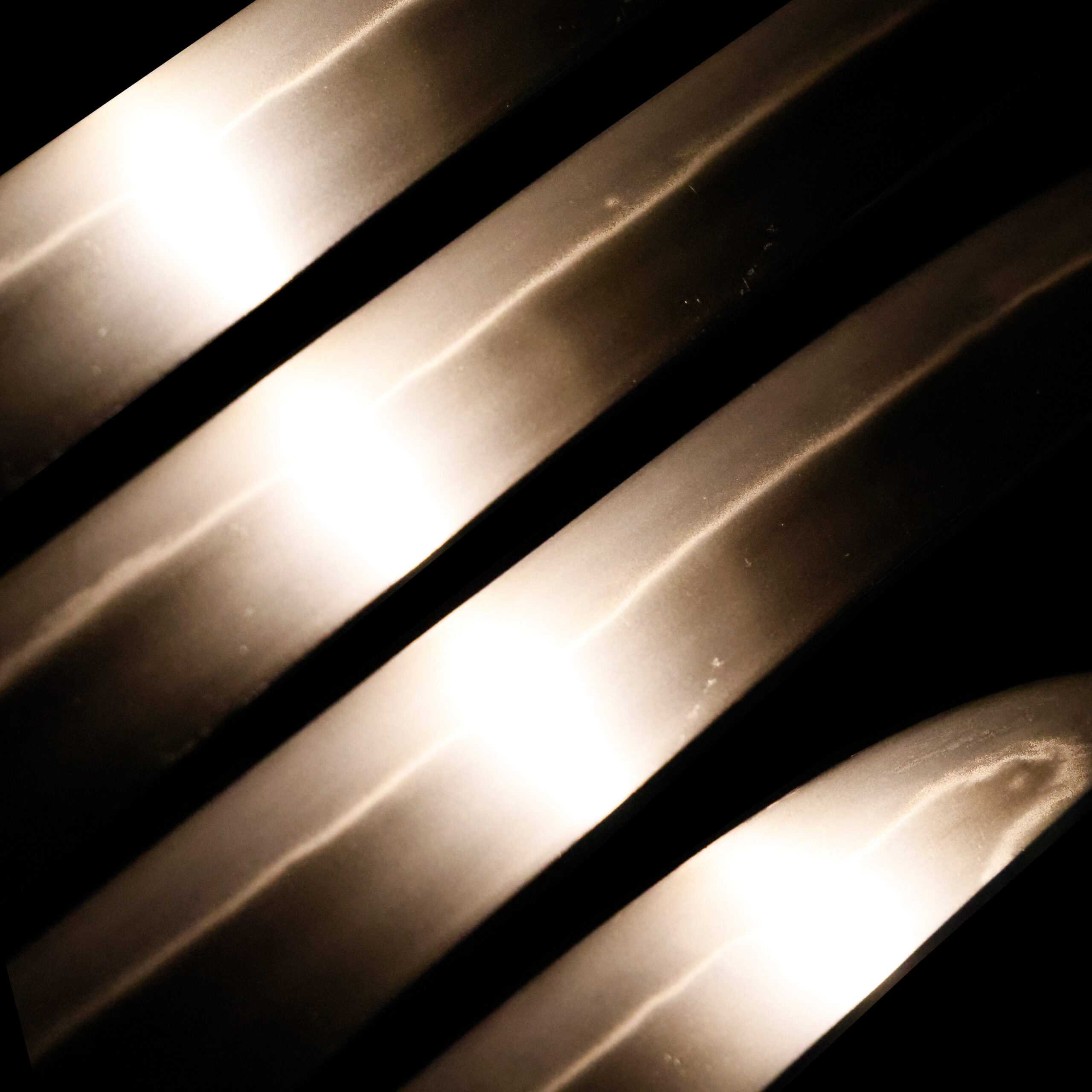
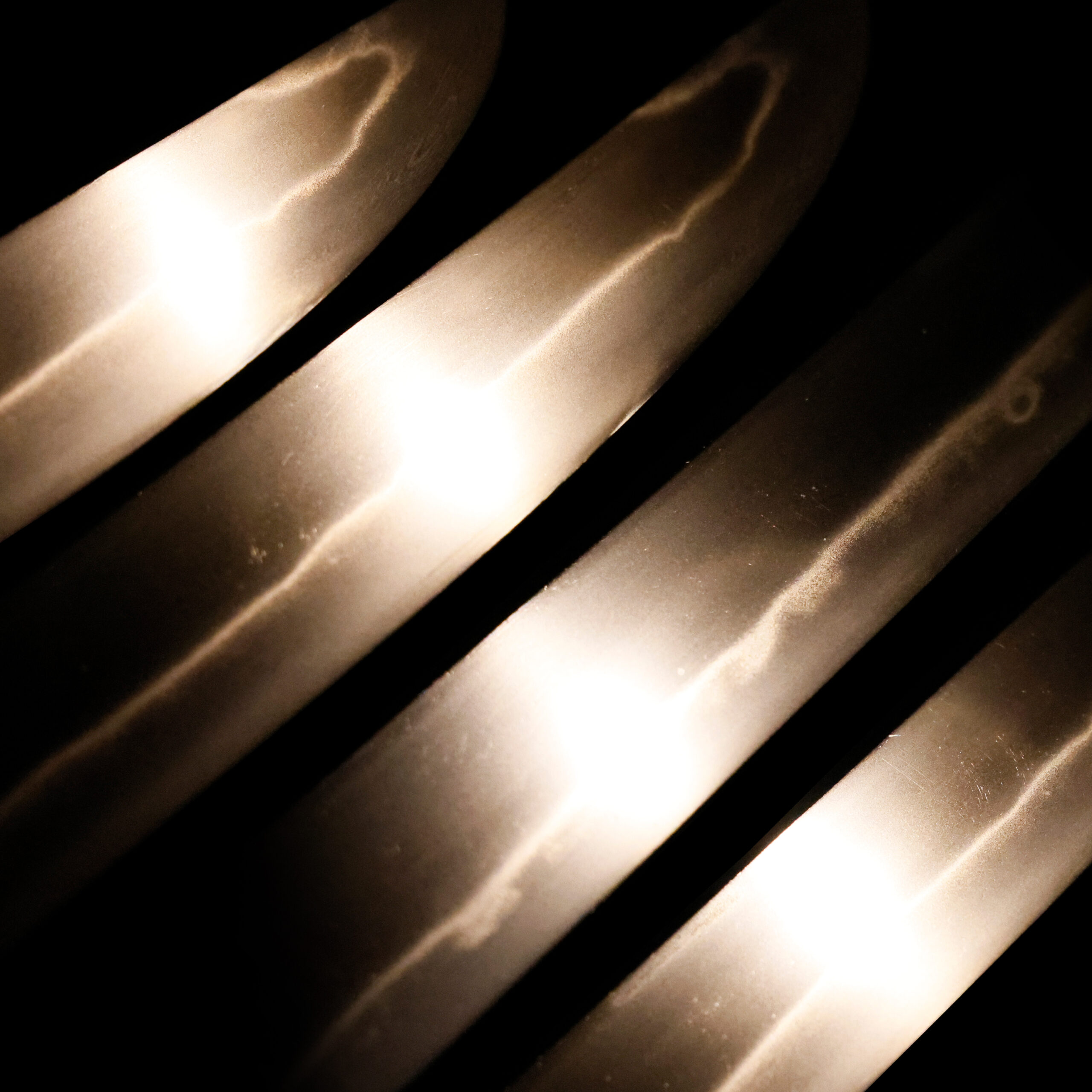
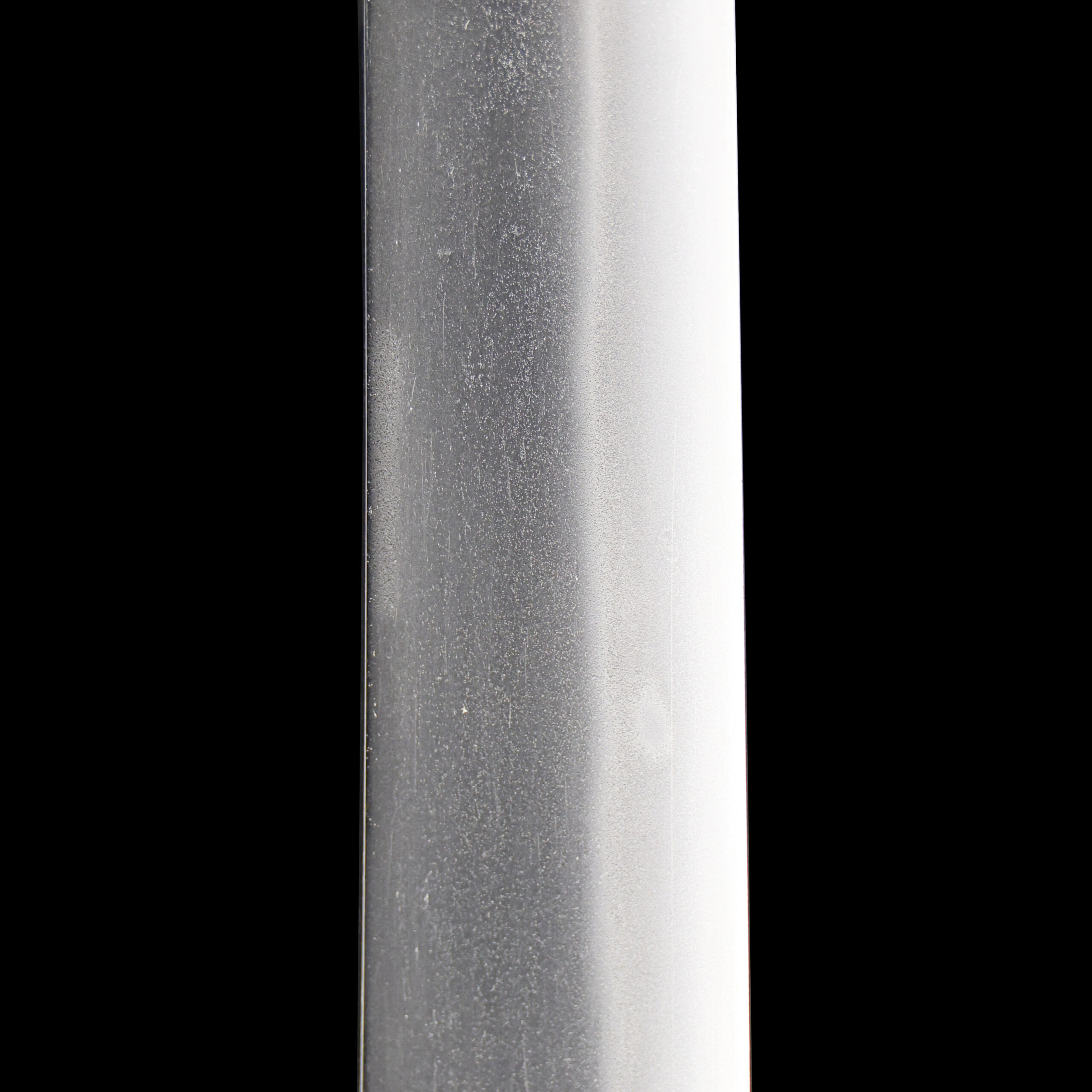
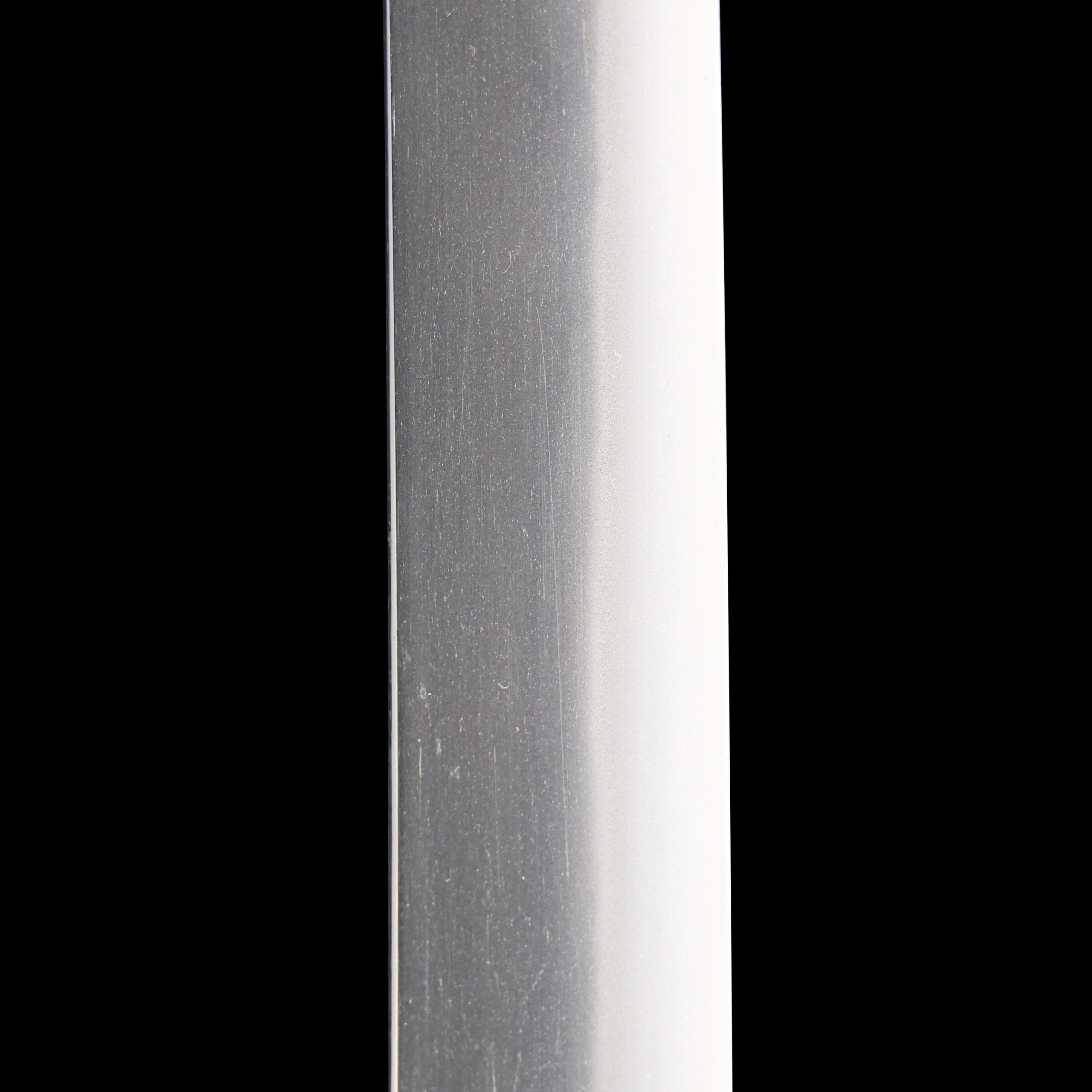
Kissaki: Kissaki is the tip of the Japanese sword.
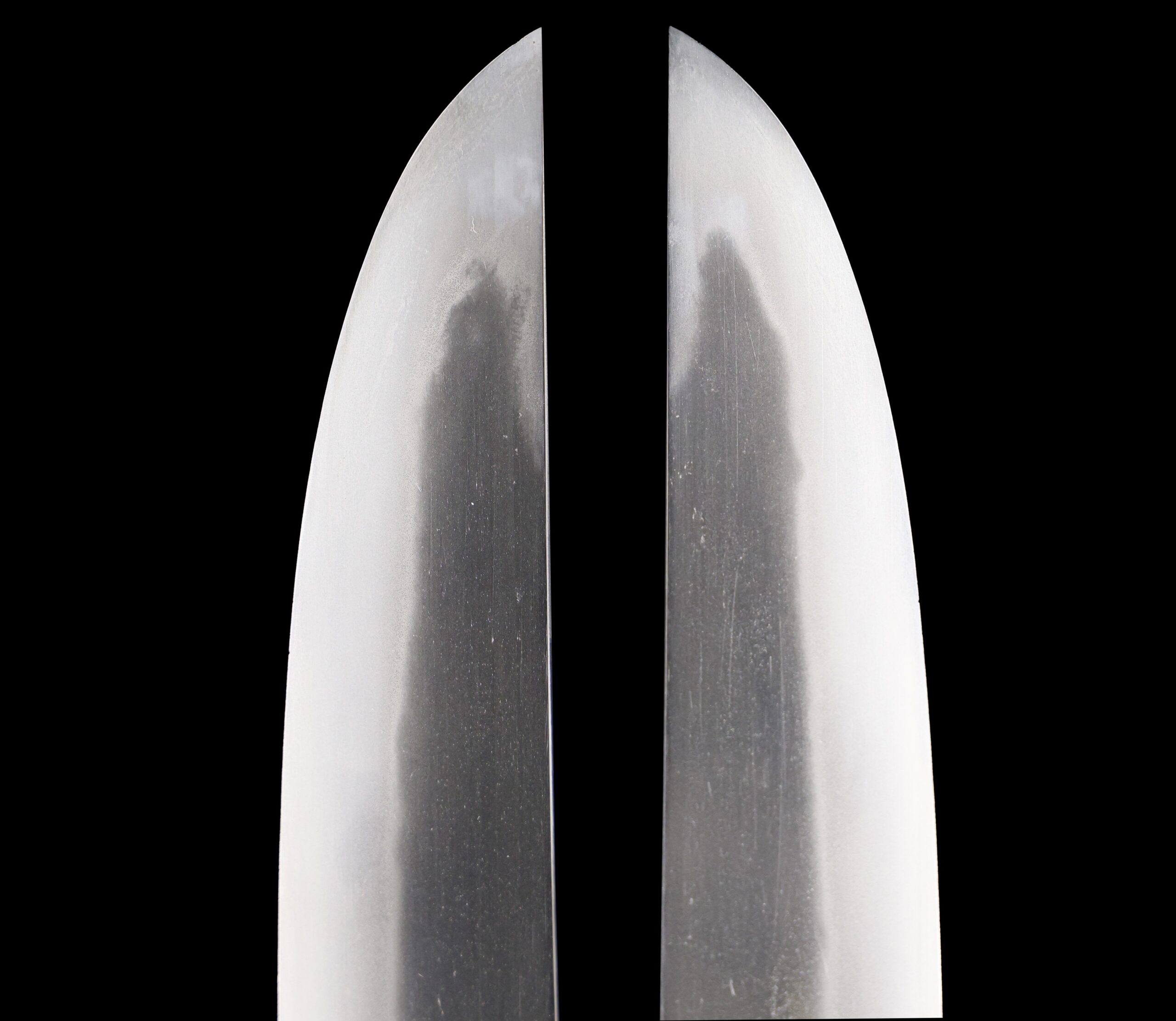
Nakago: Nakago is the tang of the Japanese sword.
Japanese swordsmiths left the black rust on the tang because it prevents red rust while the tang is in its handle. And the discoloration of the tang was created over time, and it is a great indicator for a Japanese sword specialist to estimate when the sword was forged.
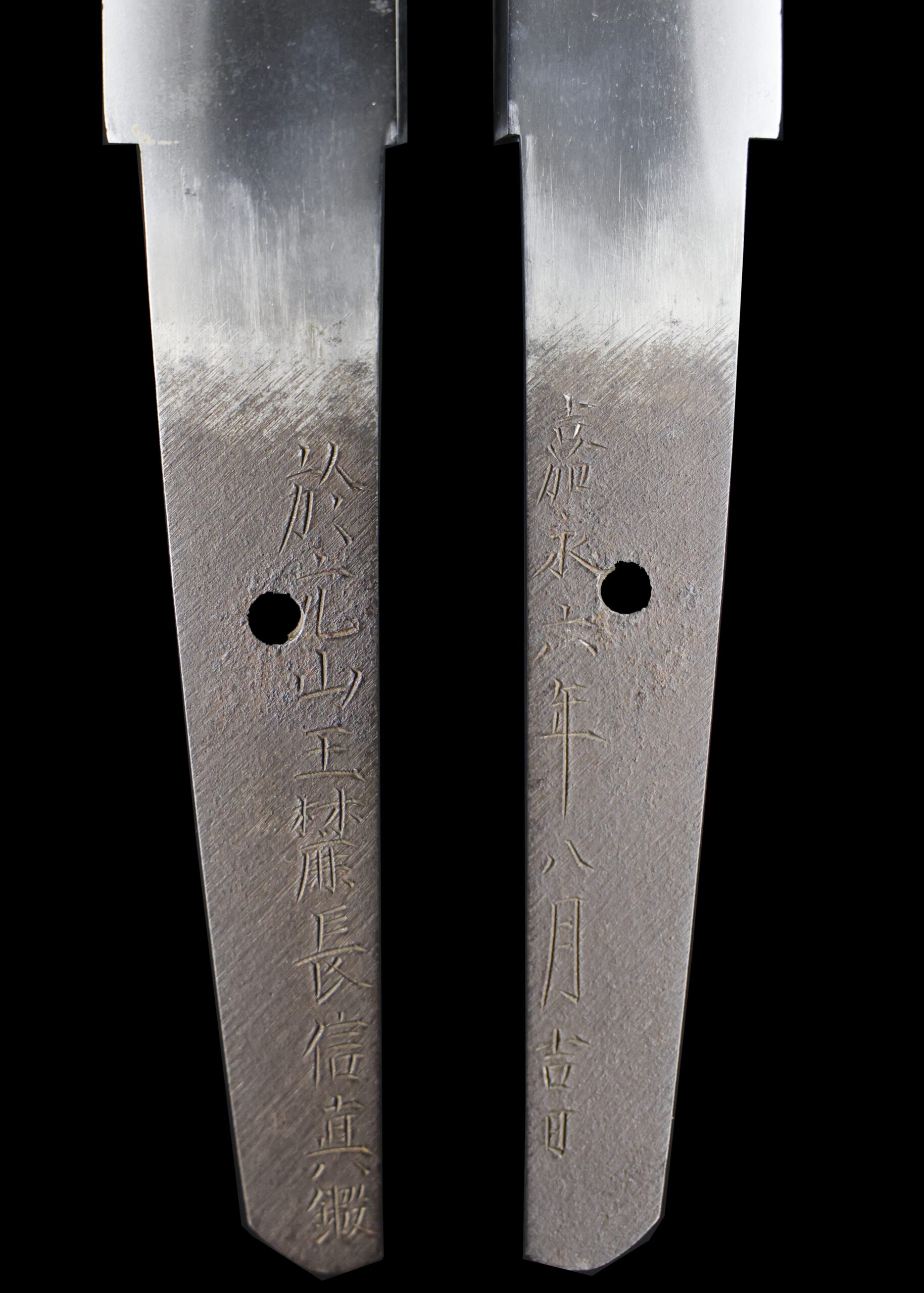
Koshirae:Koshirae is the mounting of the Japanese sword. There are several parts that consist of Koshirae such as Saya (Scabbard), Tsuka (Handle), Tsuba (Handguard).
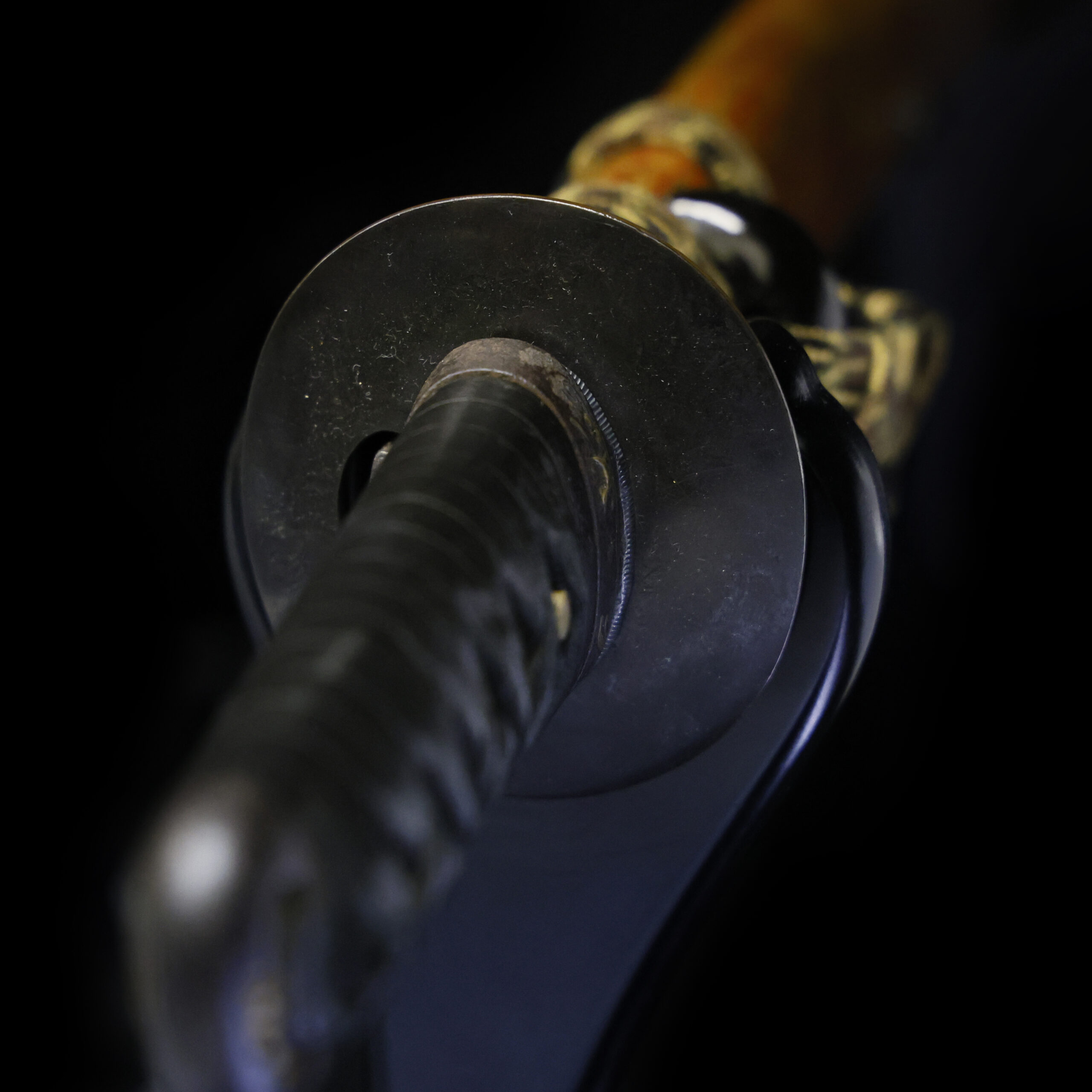
Fuchi-Kashira:A pair of matching sword fittings that cover the upper and bottom parts of its sword hilt.
The motif on this fuchigashira appears to depict karigane (雁金), or wild geese. In Japanese culture, karigane are migratory birds that symbolize seasonal change, safe return, and loyalty. Their graceful V-shaped flight and predictable migratory patterns have long been admired and used as auspicious motifs in samurai art and family crests.

Tsuka: Tsuka is the handle of the Japanese sword.
*Please keep in mind that there is no Menuki on this Tsuka.
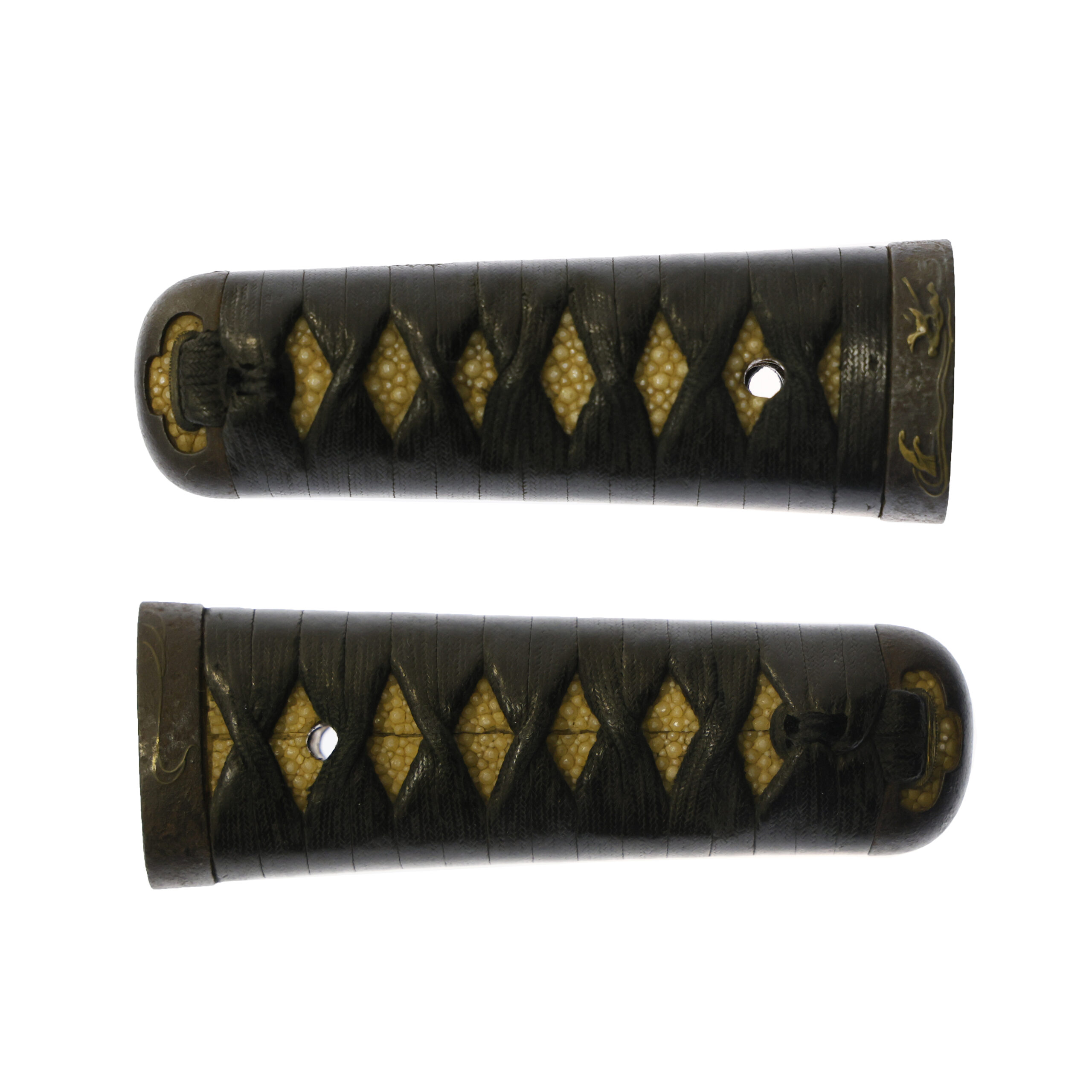
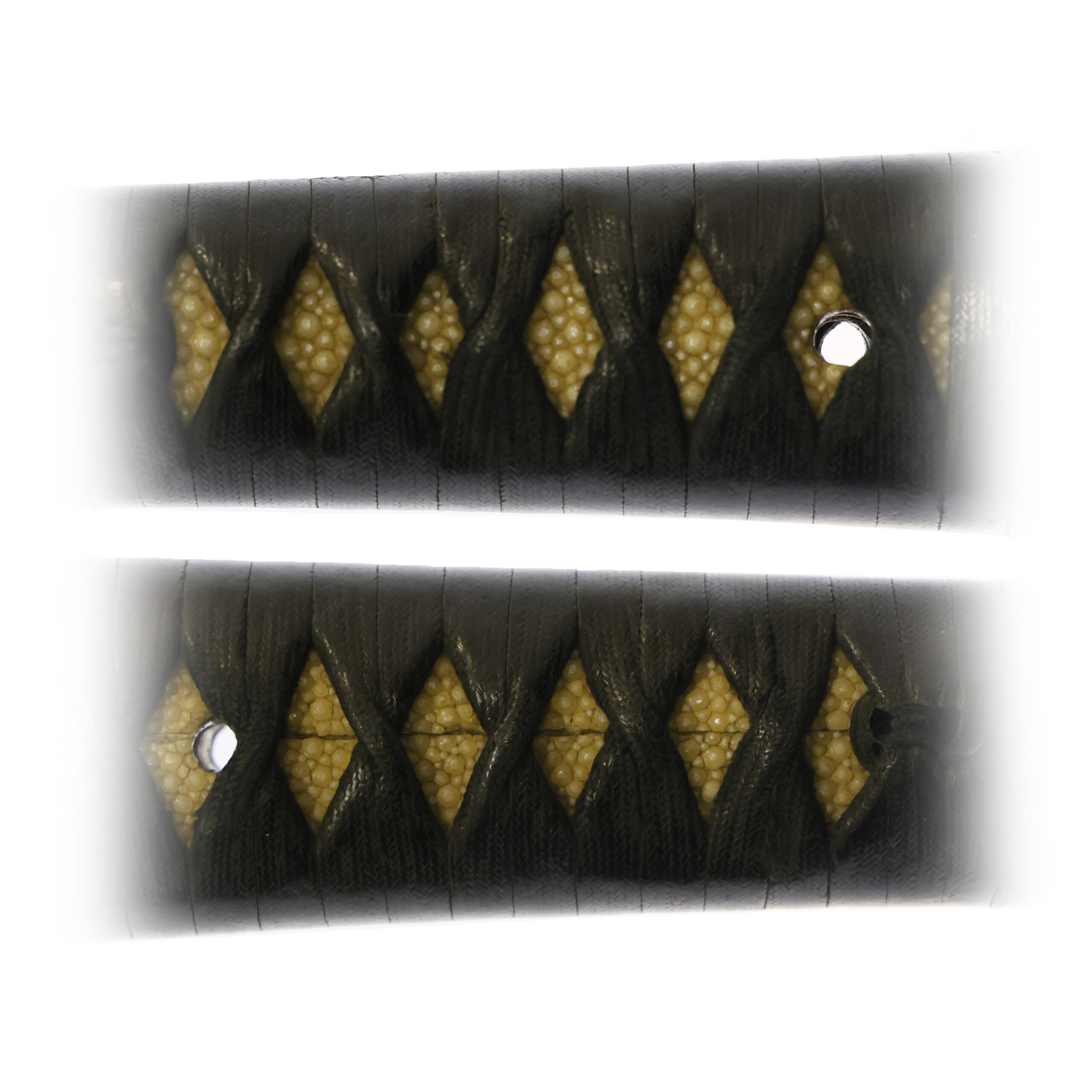
Tsuba and Habaki: Tsuba is the handguard for the Japanese Sword and Habaki is the equipment to make the blade not touch its scabbard inside. It prevents the blade from getting rusty and chipped.
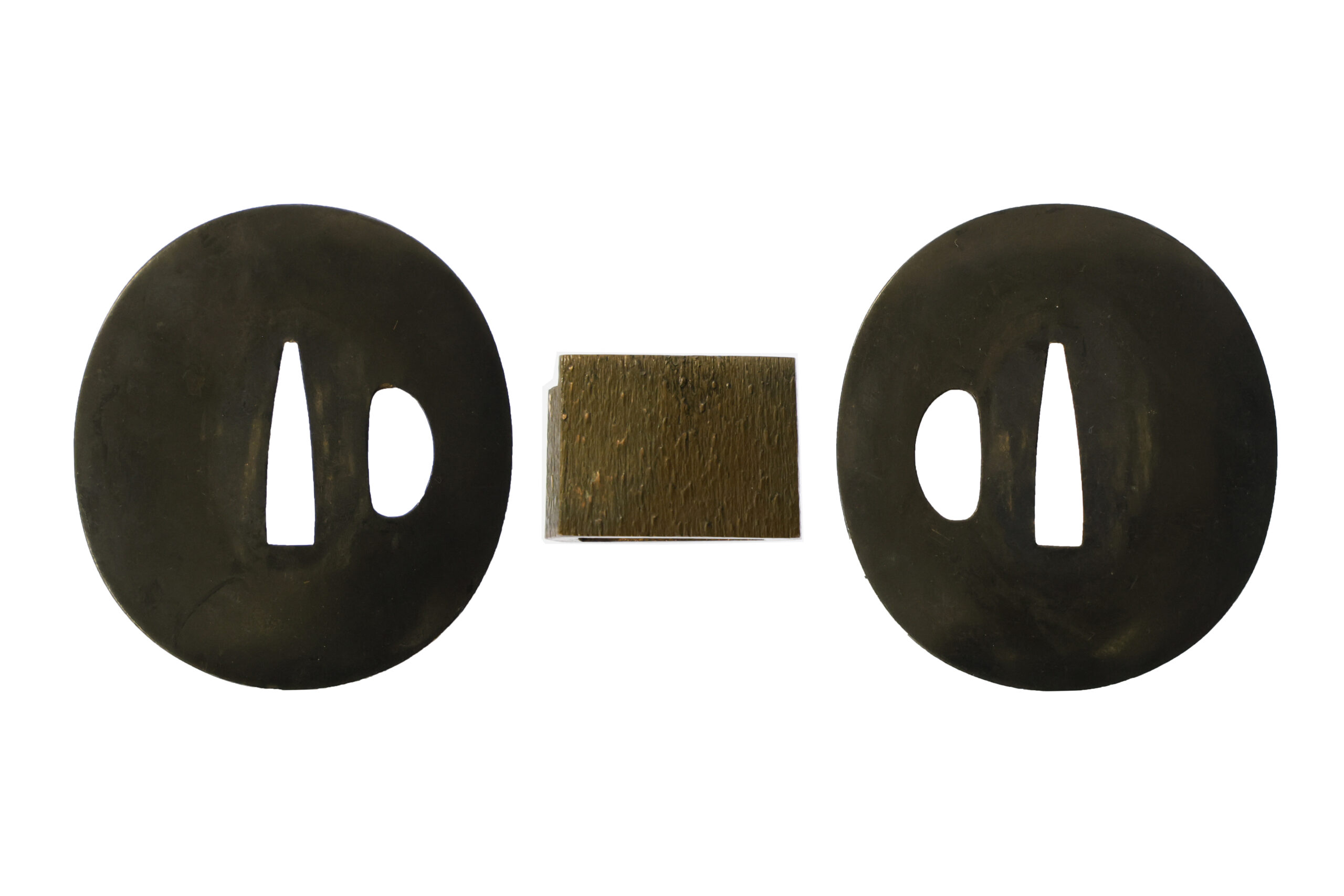
Kozuka:Kozuka is a small knife stored in Kozuka Hitsu(groove of the sheath of the Japanese sword).
This kozuka features a tsuta (蔦, ivy) motif, with slender, winding vines and small leaves elegantly rendered in gold inlay. Ivy has long been cherished in Japan for its beauty and resilience, symbolizing prosperity and longevity, and has even been used in family crests. At the right end, the “Go-san no Kiri” (五三の桐, Five-three Paulownia) crest is depicted—a formal emblem composed of stylized paulownia leaves and flowers. Historically associated with the imperial family and later adopted by the Japanese government, this crest represents authority, dignity, and tradition.
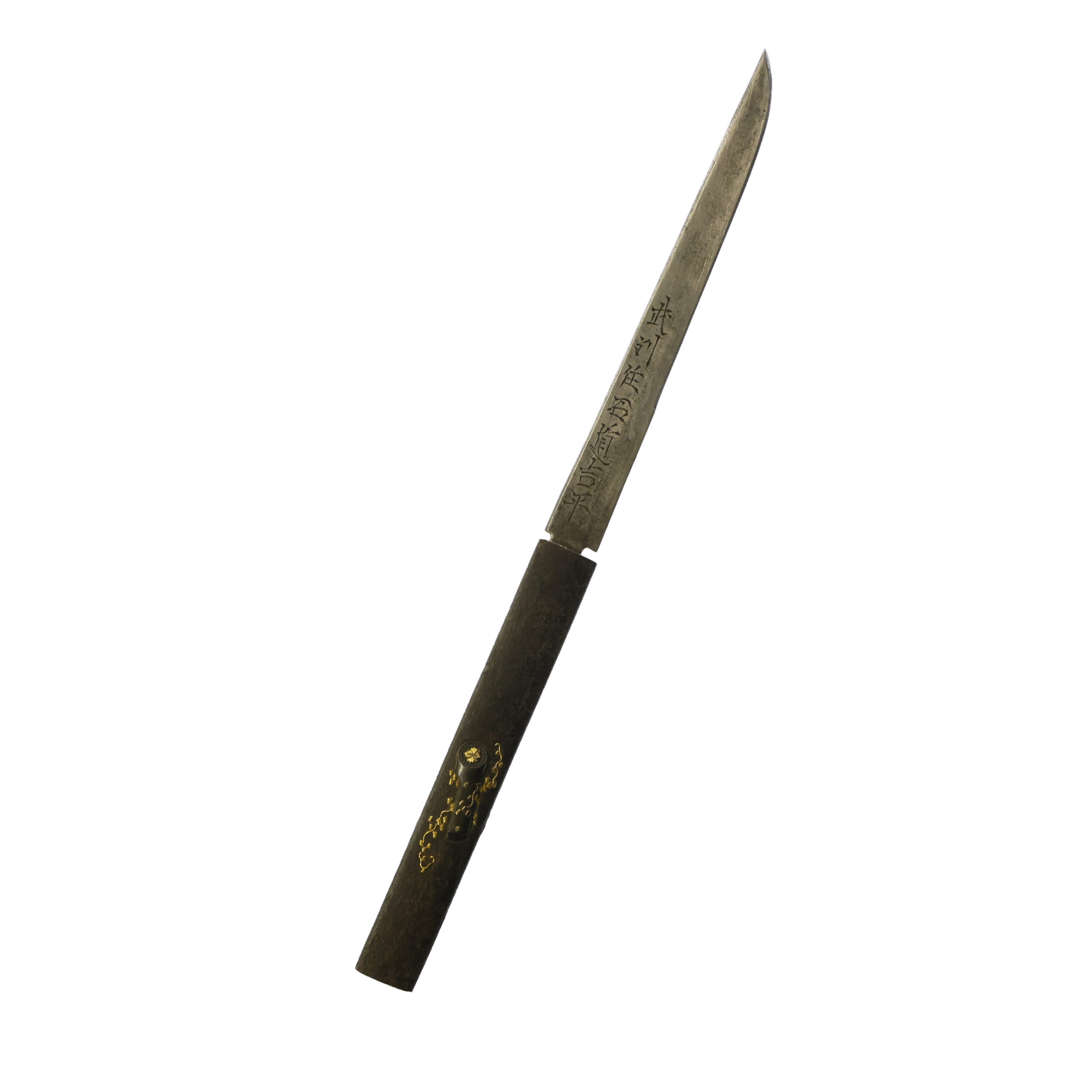
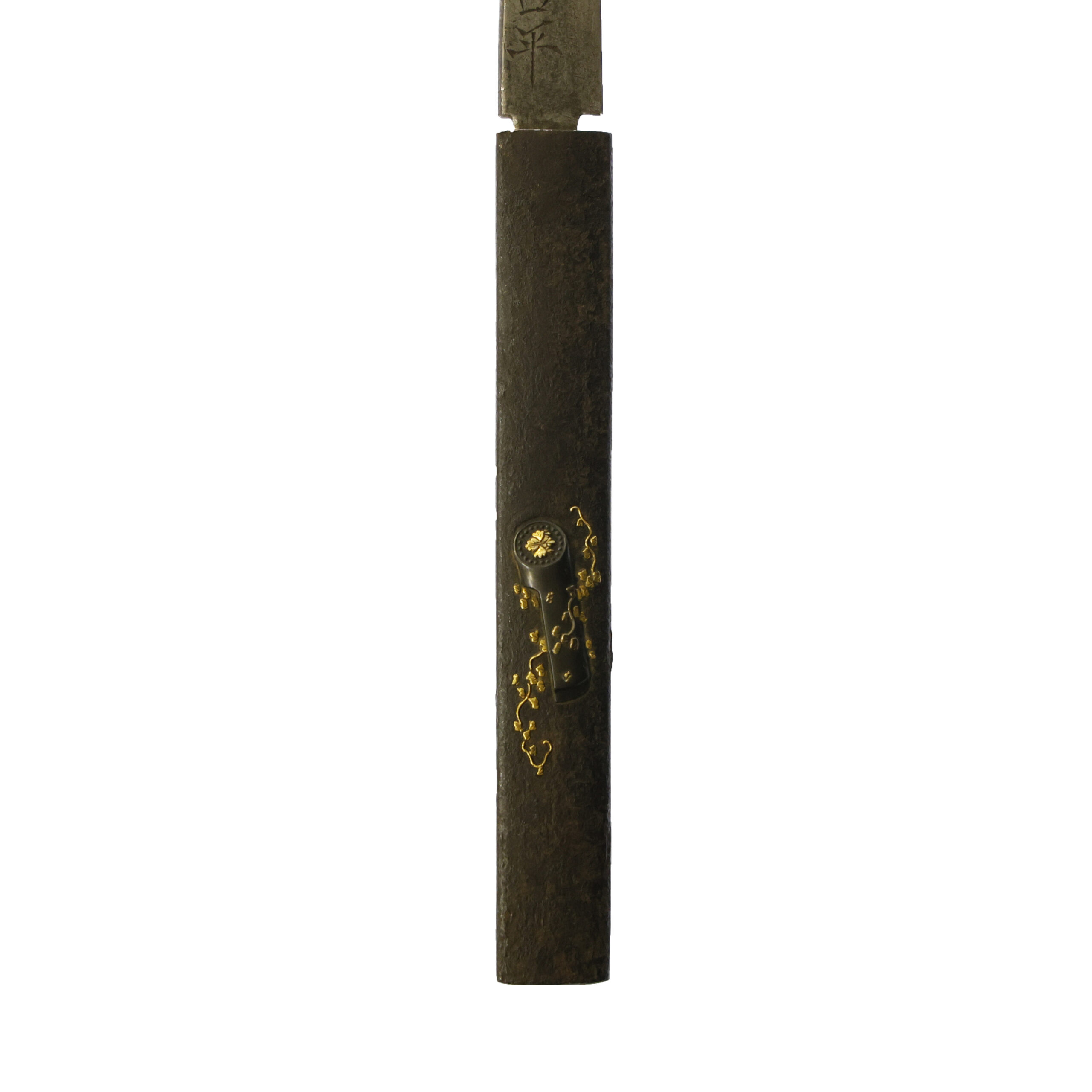
Saya: Saya is the scabbard for the Japanese sword.
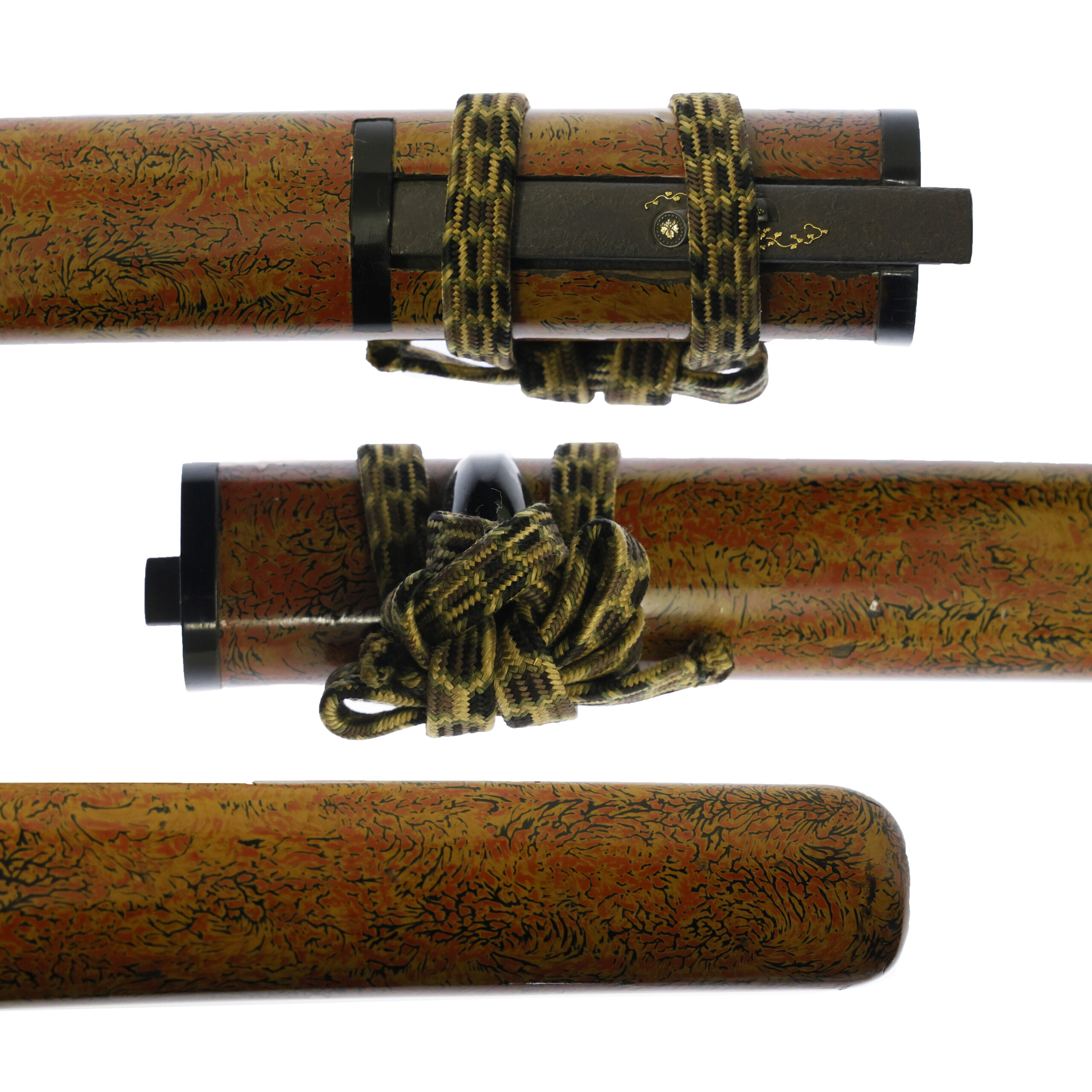
Authentication Paper: NBTHK TOKUBETSU Hozon Certificate for the blade (No. 1019751)
NBTHK, also known as Nihon Bijutsu Touken Hozon Kyokai (the Society for the Preservation of the Japan Art Sword), is one of the oldest Japanese sword appraising organizations in modern-day Japan. They authenticated the blade on March 10th in the 5th year of Reiwa (2023). They appraised it as Tokubetsu Hozon Touken, the blade especially worth preserving for Japanese society. The purchaser will receive this original certificate as well. We can also translate what is written into English and make a PDF file for your record if you request.
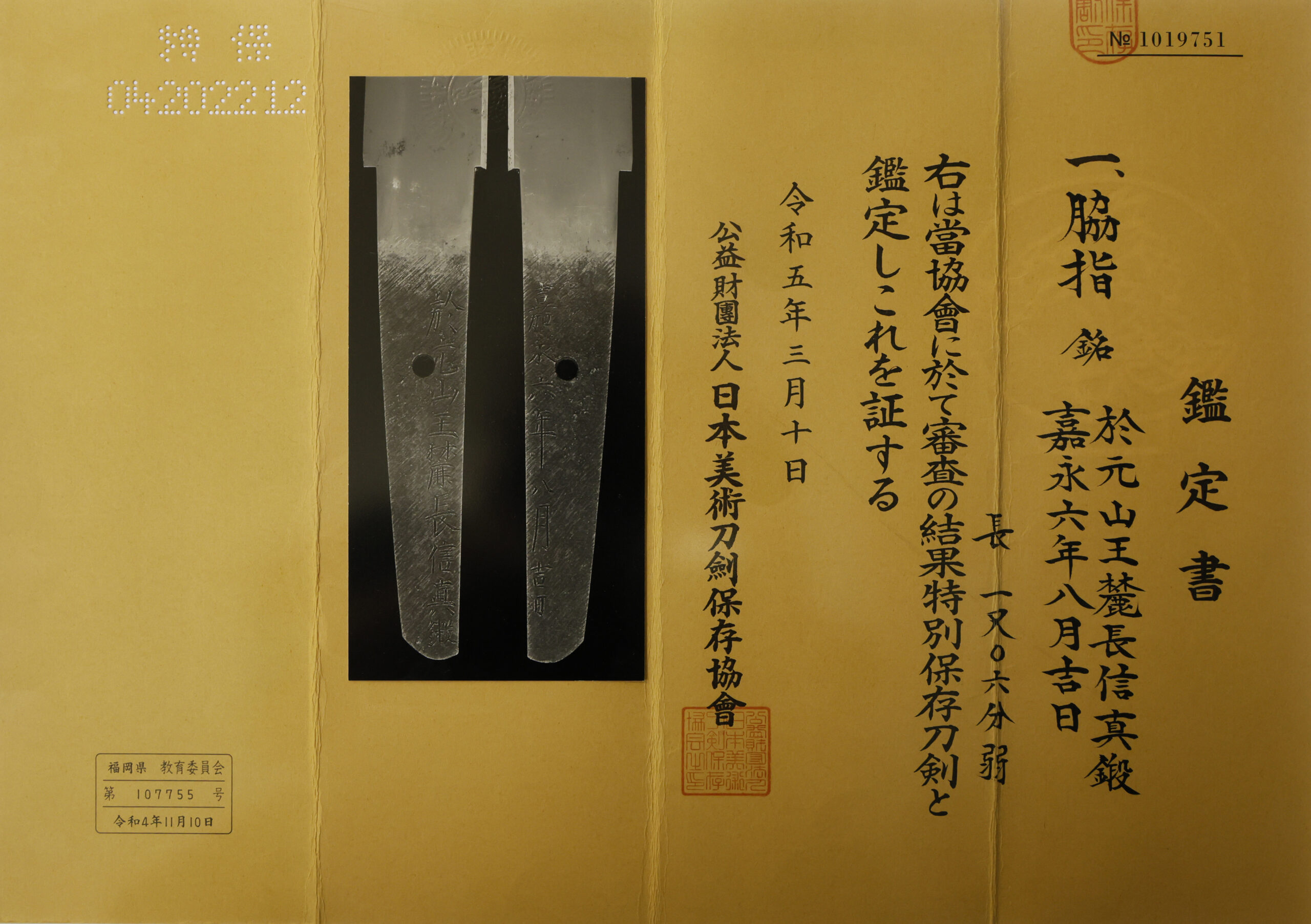
Registration Number: Fukuoka 107755
The Board of Education in Fukuoka prefecture issued a registration paper for this sword . It is called Jyu Hou Token Rui Tourokusho (銃砲刀剣類登録証). Bunkacho (The Agency for Cultural Affairs) acknowledges a Japanese sword with this paper as a work of art.
The sword needs to be traditionally hand-forged and made of Tamahagane carbon steel to be registered in the system. With this paper, its owner in Japan can legally own an authentic Japanese sword. Based on this registration number, we will apply for its export permit.
This paper will need to be returned to the board of education when the sword is being shipped abroad, but you can receive a copy of it. An English translation of this registration paper is available on request.

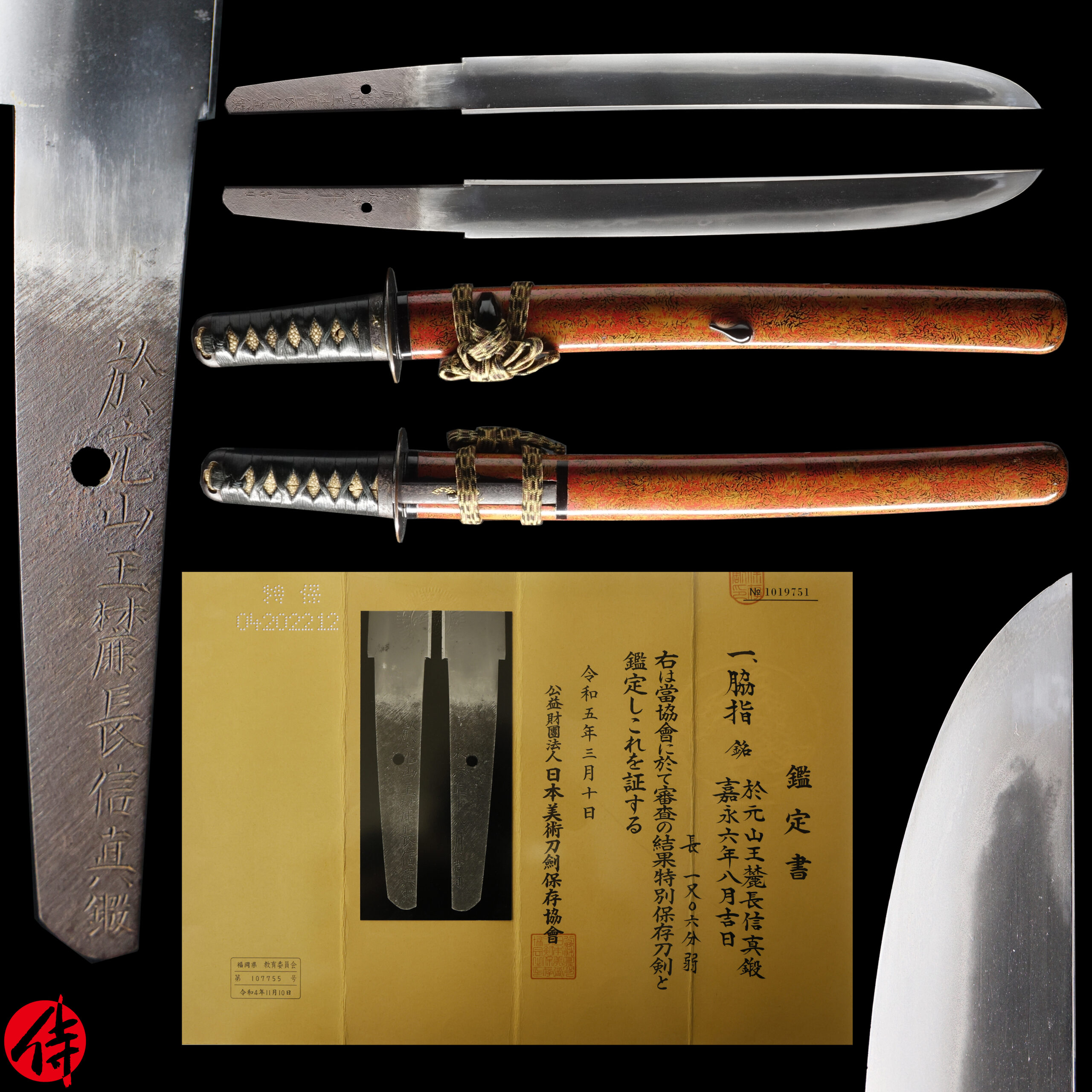
【About us】
Samurai Museum is located in Tokyo, Japan, exhibiting antique artifacts related to the Samurai history. Samurai Museum Shop is the place for those who are interested in Japanese culture and craftsmanship. We deal with antique Samurai swords/armor, traditional crafts made in Japan and so on.
【Japanese Sword& Export Process】
The Japanese swords we deal with are hand-forged edged swords made in Japan. It was made from the traditional carbon steel called TAMAHAGANE(玉鋼). Samurai Museum is familiar with the proper legal procedure for an antique/ authentic Japanese sword to be exported from Japan. We have sent more than 1000 Japanese swords for the past few years (~2025) to amazing owners who appreciate its historical value.
Each Japanese sword is registered under the Agency for Cultural Affairs and the Board of Education in Japan. They issue a registration paper for each Japanese sword for its owner in Japan to legally possess it. The Japanese sword with its registration paper means it was traditionally hand-forged in Japan.
To legally export the sword from Japan to other countries, we will have to apply for its permit to the Agency for Cultural Affairs(Bunkacho) and return the original registration paper to the Board of Education. It normally takes around 2-4 weeks to receive this permit after submitting required documents. And we would like you to expect at least 1-1.5 months for your order to arrive at your given address after you ordered. For more detailed info, please click here.
It is allowed for residents in Japan to own authentic Japanese swords without a special license as long as they come with registration papers. Please feel free to contact us if you are a resident of Japan, whether temporarily or permanently. We will also assist you when you leave Japan and need to obtain the export permit.
【Payment Method】
We accept payment through Stripe (Credit card), PayPal, Apple Pay or ChromePay, all of which are secure payment methods. Also, you don’t need to make an account on Stripe for the checkout. If you prefer other payment method, please contact us. After confirming your payment, we will apply for an export permit. You may either pay in JPY, USD, AUD, CAD,EUR CHF or GBP. The price is set in Japanese Yen. Prices in other currencies are automatically calculated based on the latest exchange rate.

* If the amount is above 1 million JPY, Stripe or wire transfer will be the only options for payment.
【Shipping】
We have shipped authentic Japanese swords to the USA, UK, Canada, Mexico, Germany, France, Hong Kong UK, and Australia. If you don’t live in these countries and like to order, please contact us first before making a purchase. We offer Free International Shipping as long as we can send antique Japanese swords by EMS.
We normally ship by EMS(Express Mail Service) provided by Japan Post. We will send you a tracking number for your order as soon as we hand it to the post office. We will put 100 % insurance on the shipping document without any extra charge. Based on the total amount, there might be a duty tax or other fee for you to pay, depending on the countries. We use package cushioning to protect the item and put it in a PVC pipe, which is one of the most secure packages because of its durability.
It will normally takes 5-14 days for the item to arrive at your given address after we dispatch it. Time of delivery is estimated as accurately as possible by the carrier but does not take into account any delays beyond our control such as by inclement weather, post office holiday seasons.
* If you live in Australia and like to purchase an authentic Japanese sword, please click here to know the detail.

【Review】
Here is one of the reviews we received from a customer who purchased an authentic Japanese sword from us. For more reviews, please click here.
“My experience overall with the whole process was wonderful. I had many questions about the history and process to purchase these treasures. All my questions were answered very timely and complete. The staff is very knowledgeable and very well versed if any questions do arise.”
【How to make sure the condition】
Please keep in mind that what you are going to purchase is an antique item. We uploaded high resolution photos for you to check its condition thoroughly. If you like to see more photos with different angles, please feel free to contact us. We will be happy to send them to you so that you can make informed decision. It is essential for us to know that you are happy with your choice of a sword. and we are prepared to use the best of our ability to serve you.
【How To Contact Us】
Please contact us through email, Facebook Messenger or Live Chat if you have any questions. You can find each icon on the right side of the website. Please click one of them to reach us. We will reply to you within 1-2 business days.
【The Art of Nihonto (Japanese Sword)】
Samurai’s history is a profound, eloquent legacy of ancient Japanese warriors in which millions of people worldwide are being fascinated. If you like to find out the art of Nihonto, please click here.
【A Guide to Japanese Sword Maintenance】
After acquiring an genuine Japanese sword, it is also important to know how to take good care of it. Here is the special video for you. Mr. Paul Martin, Japanese sword expert, shows you how to give proper maintenance to your sword. By mastering how to clean the Japanese sword, its aesthetic beauty will last forever.
When you purchase a Japanese sword from us, you can get a Free Japanese sword maintenance kit. It comes with four tools(Choji Oil, Uchiko Whetstone Powder, Peg remover, Oil Applicator). By watching the video instruction above , you can enjoy learning how to maintain your Japanese sword while appreciating it. If you have any difficulty assembling the sword or cleaning the blade, you can feel free to contact us.
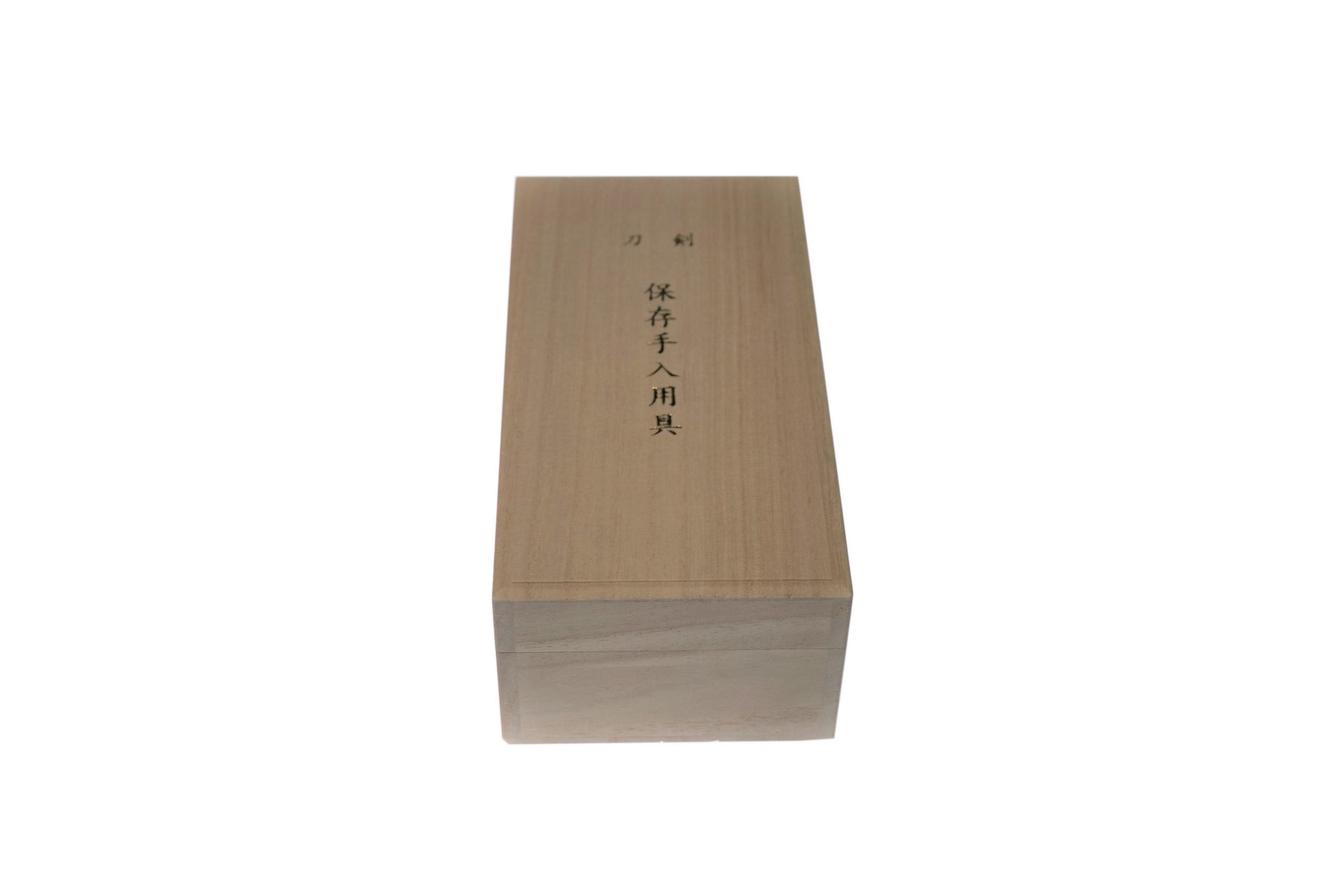
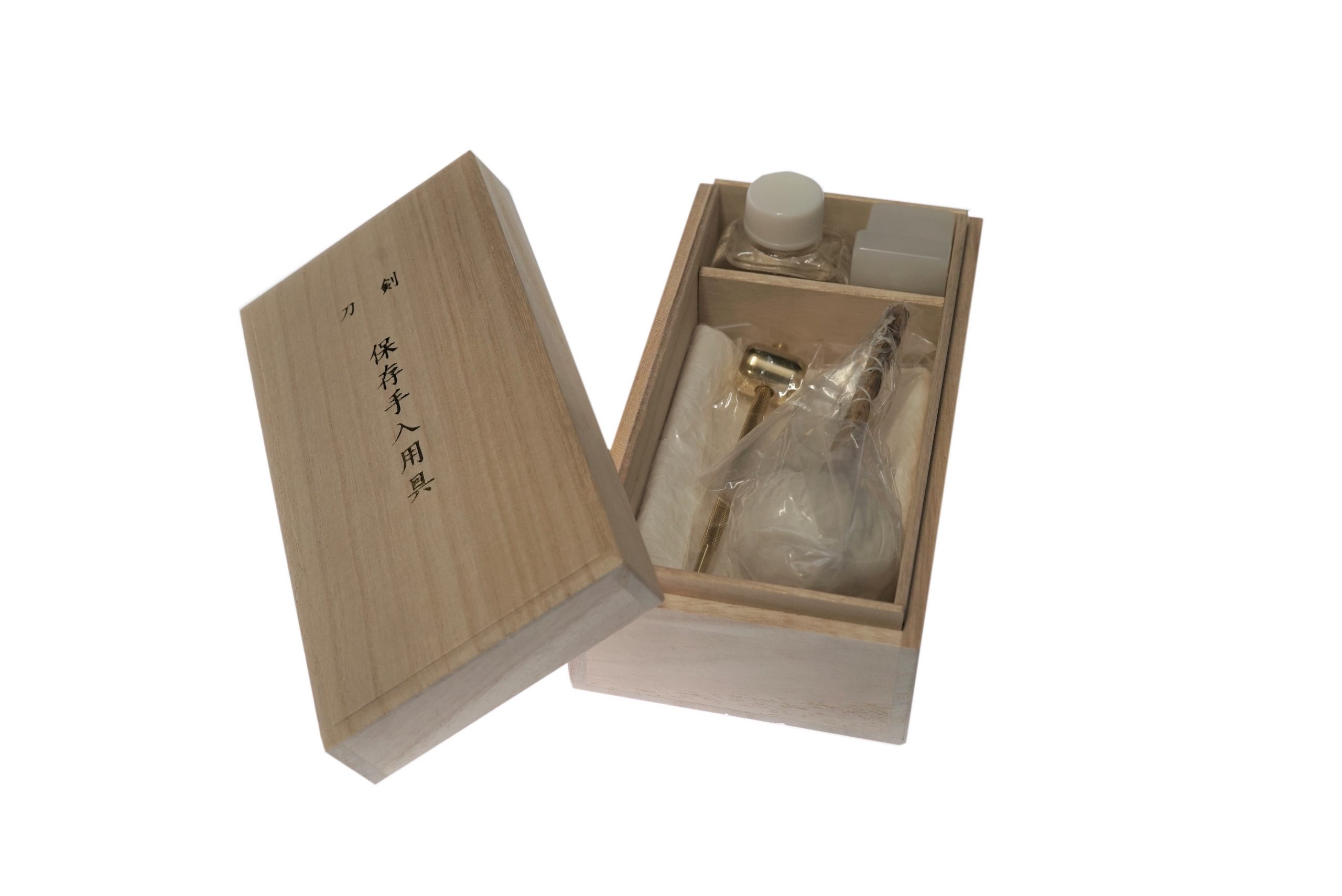
MORE ANTIQUE JAPANESE SWORD FOR SALE
SWORDS WITHOUT CERTIFICATES FOR SALE
LEARN JAPANESE SWORD TERMINOLOGY
Thank you for reading all the information on the page. If you have any difficulty choosing the right Japanese sword for you, we will be more than happy to help you find the one that speaks to you the most. Please feel free to contact us.
